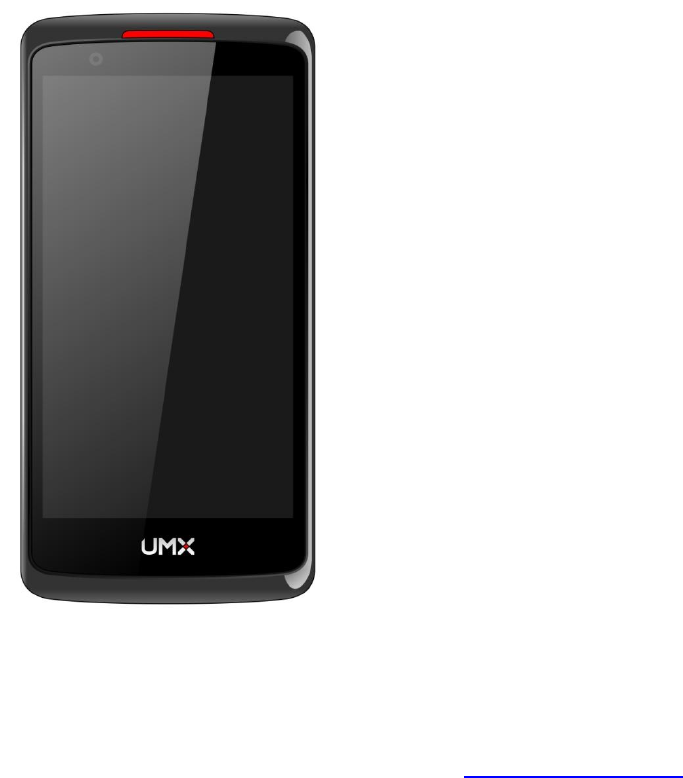Unimax Communications U675 CDMA EVDO Mobile Phone User Manual
Unimax Communications CDMA EVDO Mobile Phone
User Manual.pdf

2
Conventions used in this guide
In this user guide, we use the following symbols to indicate useful and important information:
NOTE NOTE Notes, usage tips, or additional information
Warning Situations that could cause injury to yourself or others
Caution Situations that could cause damage to your device or other equipment
3
Contents
Specifications 6
Basics 7
In Box 7
Phone Overview 7
Battery 8
MicroSD Card 9
Turning Phone On or Off 10
Phone Options 11
Touchscreen Gestures 11
Using the Onscreen Keyboard 12
Editing Text 13
Getting Started 15
Getting to Know the Home Screen 16
Customizing the Home Screen 16
Essential Display Icons 18
Notifications Panel 19
Opening and Switching Between Applications 19
Sleep Mode 20
Adjusting Volume 22
Searching Your Phone and the Web 22
Connecting Your Phone to a Computer 23
Phone Calls 24
Making Calls 24
Answering or Rejecting Calls 25
Using In-Call Options 26
Using Call Log 26
Listening to Your Voicemail 28
Using Voice Dialer 28
People 29
About People 29
Opening Your People 29
Getting Started 29
Editing/ Deleting Contacts 31
Communicating 33
Account Setting 33
4
Messaging 34
About Messaging 34
Sending Messages 34
Reading Messages 36
Receiving Emergency Alerts Messages 37
Changing Messaging Settings 37
Google 39
Gmail 39
Google Talk 41
Maps 44
Local 46
Navigation 47
Latitude 48
Calendar 50
Play Music 53
Google Play Store 54
Play Books 56
Web 58
Email 58
Browser 61
YouTube 64
Wi-Fi 67
Downloads 68
Bluetooth 69
Using Bluetooth 69
Disconnecting or Un-pairing from a Bluetooth Device 69
Connecting to a Bluetooth Headset 70
Sending and Receiving Information Using Bluetooth 70
Entertainment 71
Camera/Camcorder 71
Gallery 73
Sound Recorder 76
Facebook 76
Twitter 76
Tools 76
Clock 76
5
Calculator 78
Settings 78
Settings on Your Phone 78
Firmware Upgrade using microSD Card 84
Safety and Use 85
Please read before proceeding 85
Limitation of damages 85
Important health information and safety precautions 86
Regulatory agency identifications 93
Accessories are available at www.umxmobile.com.

6
Specifications
Display
• 4.5”WVGA
• Capacitive Touch Screen
Camera
• Primary Camera:8.0MP
• Secondary Camera:0.3 MP
Dimensions and Weight
• Dimensions: 133x 66 x 9.9mm
• Weight: 4.2 oz.
Memory
• 4GB (ROM)/4GB (RAM)
• External memory: 2GB microSD™ card included (supports up to 32GB)
Operating System
• Android 4.1
Connectivity
• BT 3.0 +EDR, Wi-Fi 802.11 b/g/n
Sensors
• Accelerometer, Proximity Sensor, Geomagnetic field sensor
Power Management (Performance)
Battery Type
Capacity
Standby Time
Talk Time
Lithium-Ion(Li-ion)
1650mAh
Up to 270Hours (11.3Days)
Up to 210minutes
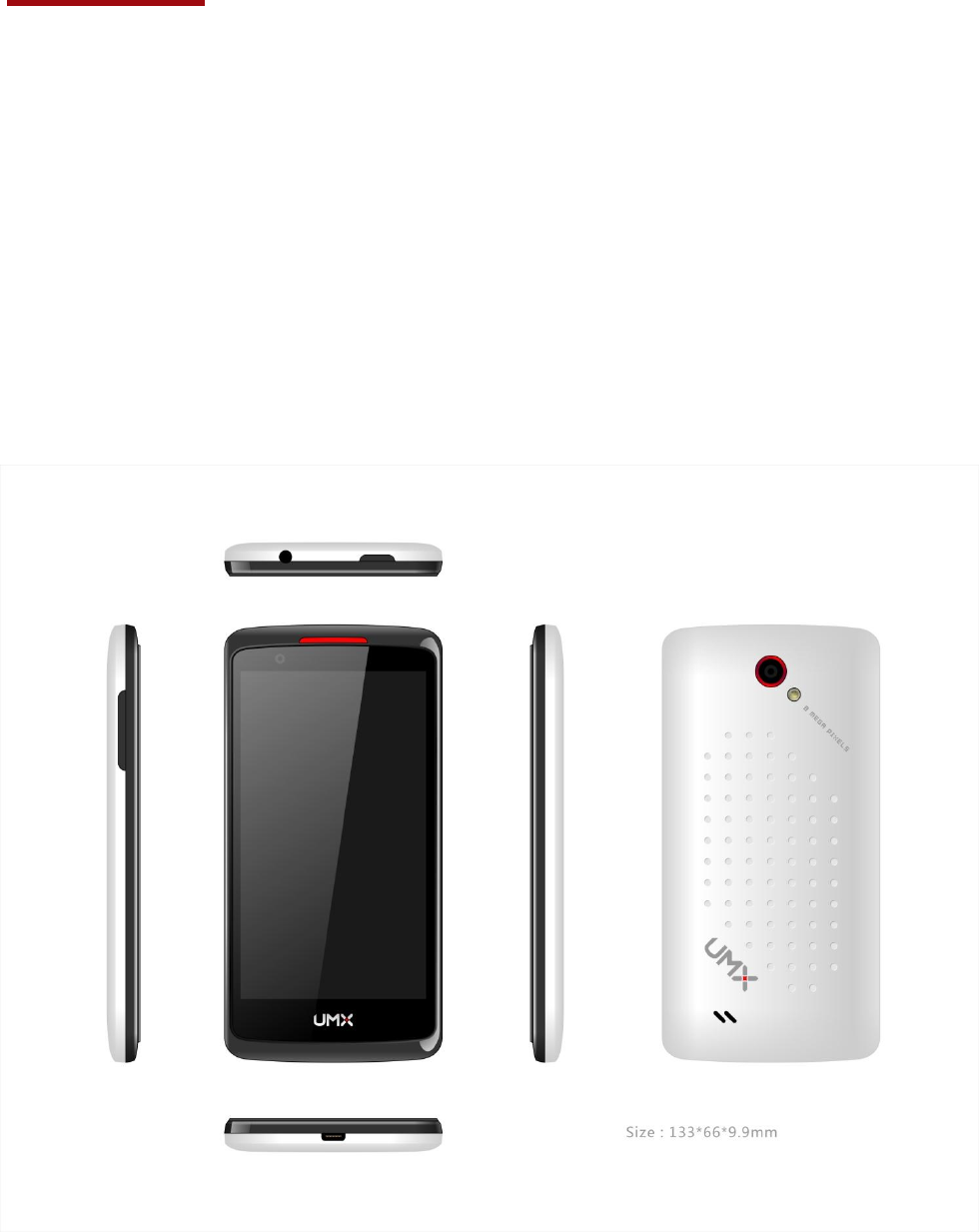
7
Basics
In Box
The U675 comes with the following items included in the box:
• Mobile phone
• Micro USB cable
• Battery cover
• Battery
• USB power adapter
• QSG
• 2GB Memory Card
Phone Overview
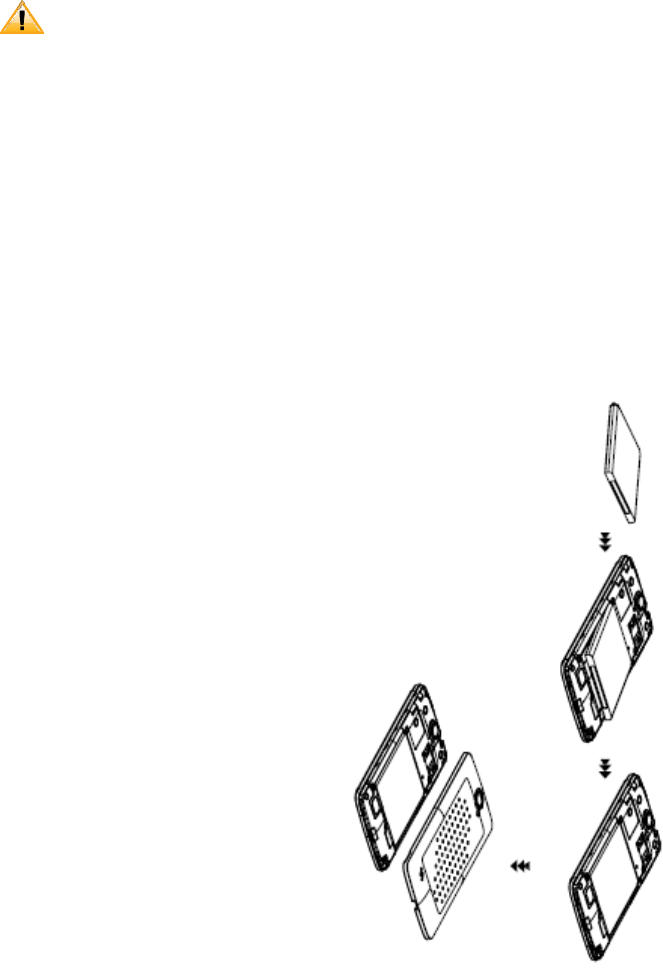
8
Battery
Note that browsing the web frequently, extended data usage, being in a poor signal area, or
subjecting the device to extreme temperatures will cause the battery to discharge quicker than
normal. To increase battery life, limit your data usage, or turn off GPS and Bluetooth when not
required.
Installing the battery
Please use only the original batteries and accessories you received with your phone or UMX recommended
replacements.
1. Remove the battery cover from the unit.
2. Align the battery’s exposed gold contacts with the battery connectors inside the battery
compartment.
3. Insert the battery with the contacts aligned to the connectors.
4. Gently push the battery into the battery compartment and press down until you hear a click.
Replace the battery door.
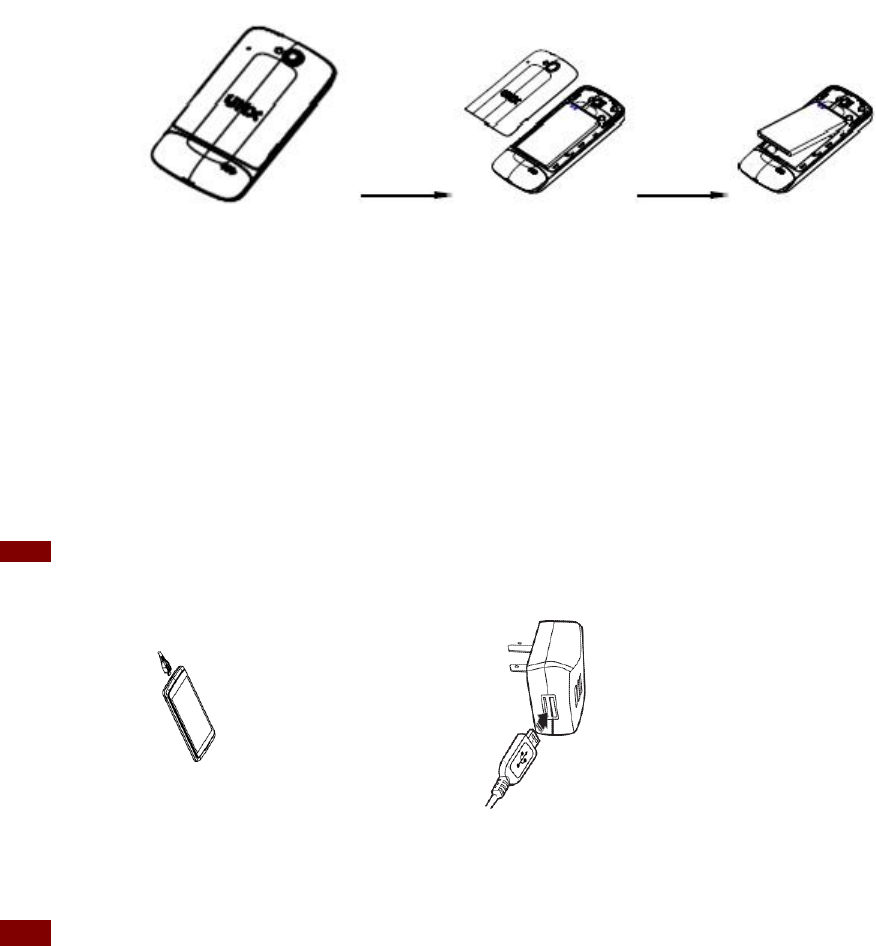
9
Removing the battery
1. Make sure that your device is turned off. To remove the battery cover from your phone, open
the back cover using your finger at the small opening on the left of the phone.
2. Push the bottom of the battery upwards and remove the battery.
Charging your battery
Before you turn on your device and start using it, it is recommended that you charge the battery.
1. Plug the USB cable into the USB power adapter.
2. Plug the power adapter into a standard outlet.
3. Locate the USB port located on the underneath of your device.
4. Plug the other end of the USB cable into the phone’s micro USB port.
5. The USB icon on the cable should always face up when connecting the cable to your device as
shown.
NOTE
• It is more efficient to charge the battery with your device powered off.
• Battery operating time gradually decreases over time.
microSD Card
Use the microSD card to store your photos, videos, music and certain apps from Google PlayTM Store.
You can also move and copy files to your computer from your device.
NOTE When you insert or remove the microSD card, you should remove the battery cover firstly then open the TF
cover.
Inserting the microSD card
1. Locate the microSD card slot and remove the cover.
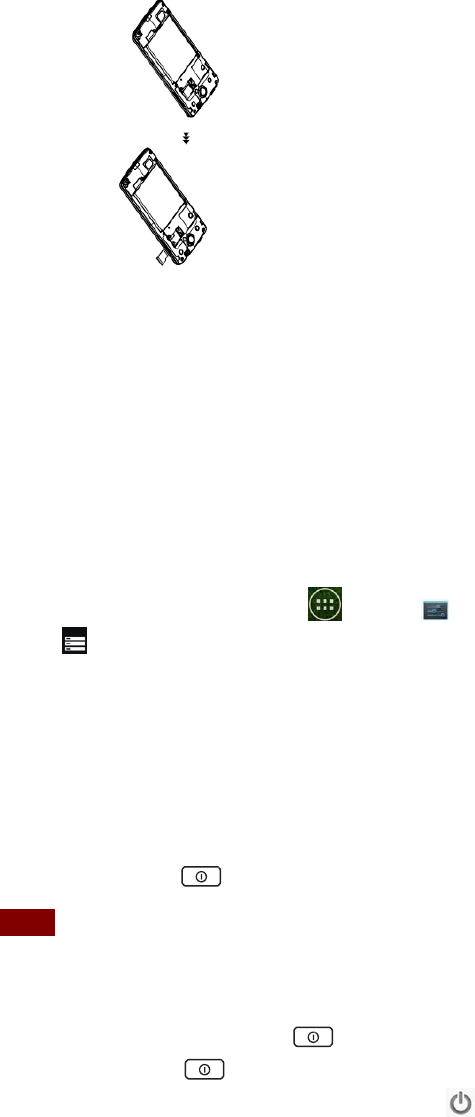
10
Insert the microSD card into the slot with its gold contacts facing left above battery until it clicks
into place.
Removing the microSD card
1. Remove the microSD card cover.
2. Press the microSD card to eject it from the slot then slide it out the rest of the way.
Removing the microSD card while the phone is on
If you need to remove the microSD card while the phone is on, unmount the microSD card
first to prevent corrupting or damaging the files in the microSD card.
1. From the Home screen, tap Apps >Settings.
2. Tap Storage >Unmount SD card >OK.
3. Remove the microSD card by following the steps in “SD card safe to remove”.
Turning Phone On or Off
Turning your phone on
1. Press and hold Power/Lock.
NOTE The first time you use your phone you’ll need to set it up. See the Getting Started chapter for details.
Turning your phone off
1. If the display is off, press Power/Lock to turn it back on.
2. Press and hold Power/Lock for a few seconds.
3. When Phone options menu appears, tap Power off >OK.
Phone Options

11
Silent mode
1. Press and hold Power/Lock to display Phone Options.
2. Tap Silent mode.
• When you select Silent mode, is displayed in the Status bar. Ringtones, alerts, and all
audible sounds except media and alarms are silenced.
NOTE To turn silent mode off, press and hold Power/Lock and then tap .
Airplane mode
1. Press and hold Power/Lock to display Phone Options.
2. Tap Airplane mode.
• When you set Airplane mode, is displayed in the Status bar. Wi-Fi, Bluetooth, and mobile
network functions are all disabled.
NOTE To turn airplane mode off, press and hold Power/Lock and then tap Airplane mode again.
Touchscreen Gestures
Tap
To select onscreen items such as application and settings icons or press
onscreen buttons, simply touch them with your finger.
Tap and hold
To open available options for the item, simply touch and hold your finger on the
screen over the item.
Swipe or slide
Quickly drag your finger vertically or horizontally across the screen.
Drag
Tap and hold your finger before you start to drag. While dragging, do not
release your finger until the item reaches your desired location.
Flick
Flicking the screen is similar to swiping, but you only need to swipe your finger
in lighter and quicker strokes. This finger gesture is always in a vertical
direction, such as flicking through the contacts or the message lists.
Rotate
For most screens, you can automatically change the screen orientation from
portrait to landscape by turning the phone sideways. When entering text, you
can turn the phone sideways to bring up a bigger on-screen keyboard.
Using the Onscreen Keyboard
You can enter text using the onscreen keyboard. Some applications open the keyboard
automatically. In others, tap anywhere in a text field to open the keyboard.
1. Tap each letter on the on-screen keypad.
2. Tap and hold a letter for additional key options (not all keys have additional options).
Additional key options include numbers and letters with accent marks. If options are available,
you will see a box with all the options shown. Slide your finger to select the character you want.
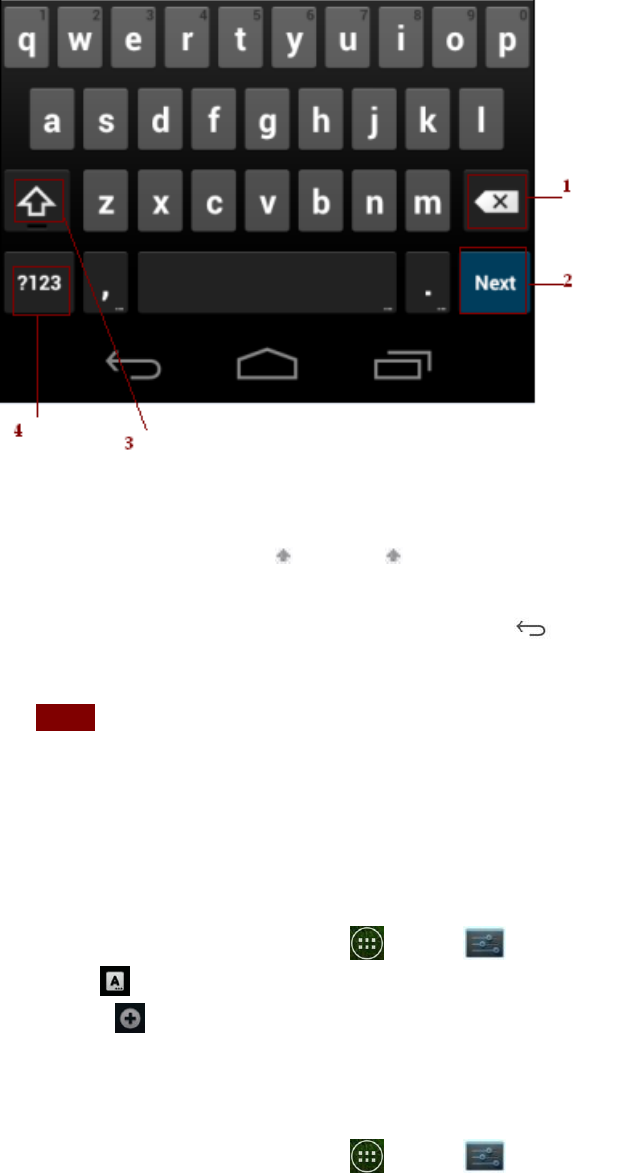
12
3. Continue until you have finished the word.
You can also use the following icons:
Tap 3 while you type. When you release the key, the lowercase letters reappear.
•Turn caps lock on. double-tap or touch & hold
Tap 3, so it changes to . Touch shift key again to return to lowercase.
•Tap 1 you can to delete words, tap 4 you can change to the number and sign keyboard.
To hide the Android keyboard, press Back .
•When you write a new message, you can tap 2 to skip from the receiver frame to text frame.
NOTE When you type the notification panel will have a “select input method” you can set the input methods.
Adding, Editing or Deleting Words in the User Dictionary
Sometimes you may need to add a word to the predictive text dictionary, for example, a name or a
specialized technical word. If you want to add a word to your User dictionary while entering text,
double tap the word to highlight it, then tap and hold the word and select Add ** to dictionary.
Adding a word manually
1. From the Home screen, tap Apps >Settings.
2. Tap Language & input >Personal dictionary.
3. Press Add.
4. Type the word >tap OK.
Editing or deleting a word
1. From the Home screen, tap Apps >Settings.
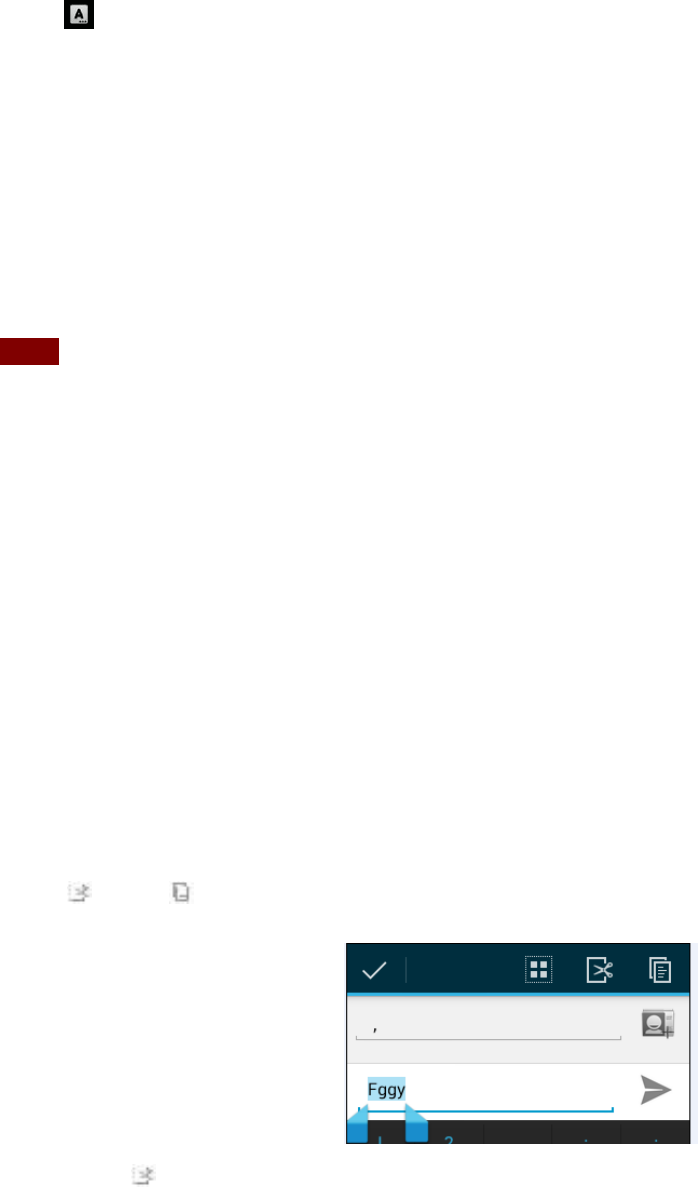
13
2. Tap Language & input >Personal dictionary.
• To edit words from the dictionary, tap the word you want to edit >Edit > Edit the word > Tap
OK.
• To delete words from the dictionary, tap the word you want to delete >Delete.
Editing Text
You can select, copy or cut the text you’ve entered, then paste it in another text field within the user
interface.
NOTE Some applications may offer different text editing methods.
Selecting text
1. Tap the text field.
2. Move the cursor to the beginning or end of the desired text by tapping in the location you want
the cursor.
3. Tap and hold the text field.
4. Tap Select word in the pop up menu.
• Or tap Select all to select all the text in the text field.
5. Drag your finger to move the text cursor to a letter within the text that you want to select. The
selected text is highlighted in orange.
Cutting and copying the text
1. Double-click to select the text to cut or copy it.
2. Tap and hold the selected text.
3. Tap Cut or Copy in the menu that opens.
• If you tap Cut, the selected text is removed from the text field. In this case, the text is saved
to the clipboard, so that you can paste it into another text field.
Pasting the text
1. Cut or copy the text to paste.
2. Tap the text field where you want to paste the text and move the cursor to your desired location.
14
• You can paste text that you copied from one application into the text field in any other
application.
3. Tap and hold then select Paste in the pop up menu.
• The text is inserted after the cursor. The text also remains in the clipboard, so you can paste
that same text into another location.

15
Getting Started
Google Account
You must sign in to a Google account to use Gmail, Google Calendar, and other Google
applications; to download applications from Google Play Store; to back up your settings to Google
servers; and to take advantage of other Google services on your phone.
Registering a Google account
Gmail, Google Play Store, and other applications require a valid Google account for use. You will be
prompted to login into Google the first time you use these applications.
1. Tap Existing>Sign in to register your Google account.
• If you don’t have a Google account, tap New instead. See the next section for more details.
2. Enter your Google account Email and Password > Tap Sign in.
Creating a new Google account
1. Tap New > Enter First name, Last name and Email > Tap Next.
2. Enter a password in to the Type a password, Confirm password fields, then tap Next.
• Password tip: Your password must be a minimum of 8 characters in length.
3. Select Security question and enter the Answer, which will be needed if you forget your
password and then enter a Secondary Email >Create.
4. Read through Google Terms of Service > Tap I agree, Next.
5. Enter the letters shown on the screen > Tap Next > Tap Finish.
Adding a Google account
1. From the Home screen, tap Apps >Settings.
2. Tap Accounts & sync >Add account.
3. Tap Google > Tap Existing.
4. Tap Sign in to register your Google account.
5. Enter your Google account Email and Password > Tap Sign in >Finish.
• The U675 supports multiple Google accounts.
• If you have the same contact across multiple Google accounts, you can merge duplicates into a
single item in the contact list.
Add a Google account
1. From the Home screen, tap Apps >Settings.
2. Tap Add account.
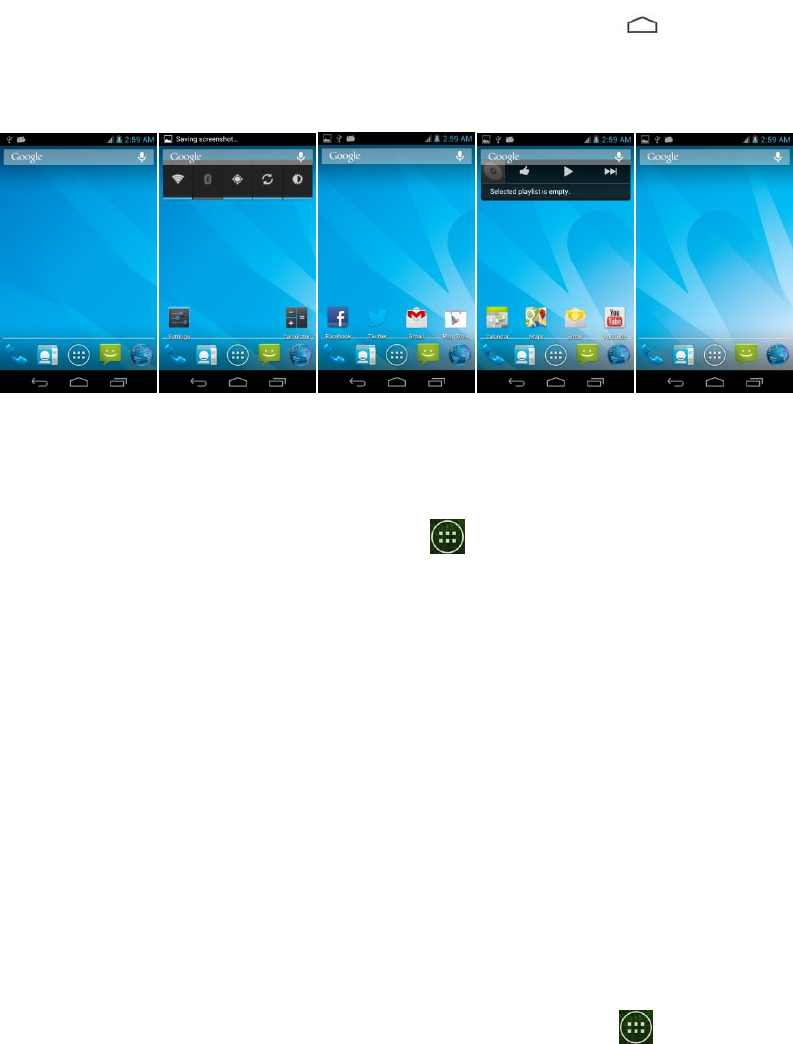
16
Getting to Know the Home Screen
The Home screen is displayed when the device is in idle mode. You can add your favorite apps,
shortcuts, folders and widgets to the Home screen so they’re only a tap away.
The Home screen is actually five separate screens. Slide your finger the left or right and you’ll
discover more space to add icons, widgets, and more. Press Home to return to the center Home
screen.
Previewing the Home screens
1. From any Home screen, tap and hold Apps.
2. When you choose a desired Home screen, the display shifts to the selected Home screen.
Customizing the Home Screen
The Home screens and display wallpaper are customizable.
Home screen customization options
Open the Home screen you want to customize.
Moving an item on the Home screen
1. From the Home screen, tap and hold the item you want to move until it vibrates. Don’t lift your
finger.
2. Drag the item to a new location on the Home screen.
3. Lift your finger at the location where you want the item.
To add a shortcut for any application to a Home screen, tap Apps, tap and hold the item, then
drag it onto a Home screen.
Removing an item from the Home screen
1. From the Home screen, tap and hold an item until it vibrates. Don’t lift your finger. The

17
× Remove icon will appear at the top of the display.
2. Drag the item to × Remove.
3. When the item turns blue, lift your finger.
Changing the Wallpaper of the Home screen
1. From the Home screen, tap and hold any empty area on a Home screen long time.
2. Tap one of the following:
Gallery: Choose a photo from your camera gallery or memory card storage. You
can crop the image before setting it as the wallpaper.
Live wallpapers: Choose from pre-loaded animated wallpapers. Additional live wallpapers
can be downloaded from the Google Play Store.
Wallpapers: Choose from the pre-loaded animated or static wallpapers. Additional
wallpapers can be downloaded from the Google Play Store.
3. Tap Set wallpaper.
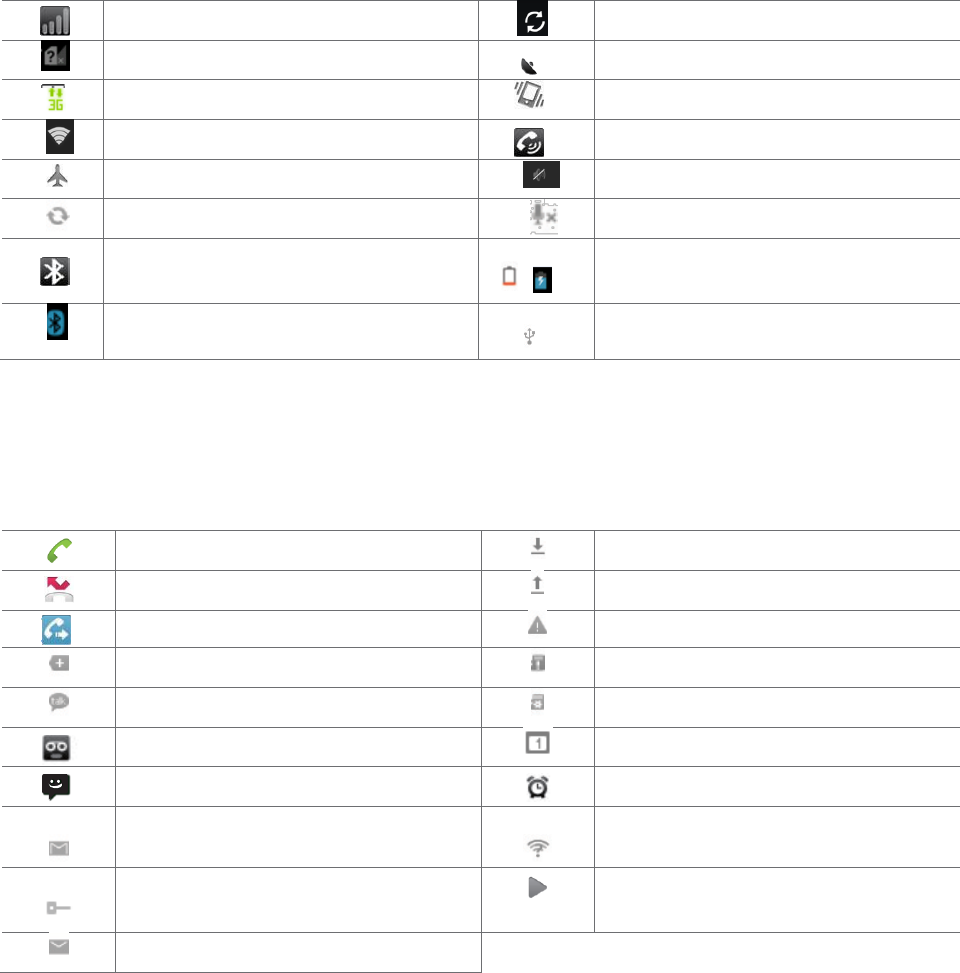
18
Essential Display Icons
Status icons
You can tell a lot about your phone when you understand the icons in the Status bar. Here’s what
each one means:
Signal strength
Synchronized with the web
No signal
GPS is active
3G network connected
Vibrate only mode
Wi-Fi signal strength
Speakerphone is on
Airplane mode
Silent mode-no audio or vibration
Data synchronizing
Microphone is muted
Bluetooth is on
~
It indicates that battery is remaining
(Empty to full charge states)
Bluetooth device connected
Connected to a computer via USB
cable
Notification icons
Notification icons in the Status bar alert you to items that may require your attention such as new
messages, calendar event reminders, missed call notifications, etc. Here’s what each one means:
Call in progress
Downloading data
Missed call
Uploading data (animated)
Call Diverted
General Warning Icon
More (not displayed) notifications
No microSD card installed
New Google Talk instant message
MicroSD card is being prepared
New voicemail
Upcoming event
New message
Alarm is set
New Gmail
Wi-Fi is on and wireless networks
are available
Connected to or disconnected from
VPN
Song is playing
New Email
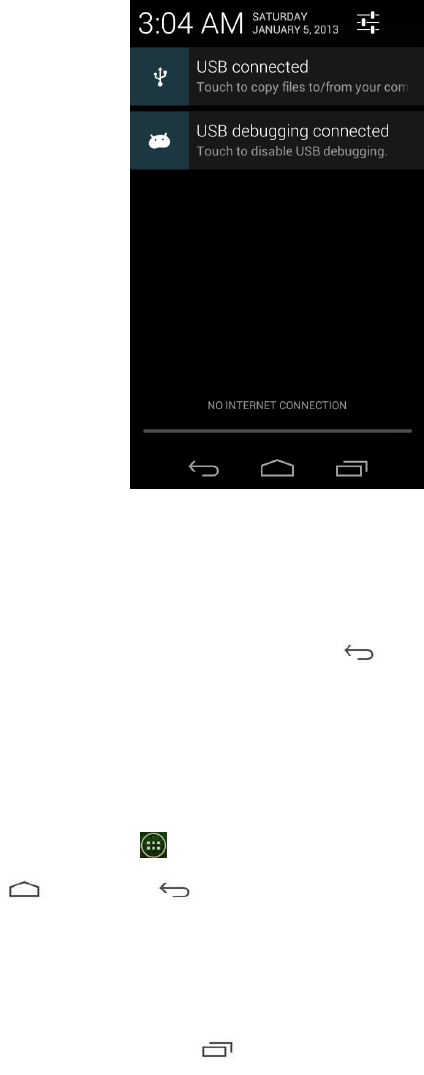
19
Notifications Panel
When you receive a new notification, an icon will be displayed in your status bar at the top of your
screen.
Viewing and responding to Notifications
1. Tap and hold Status bar, and then slide your finger downward to open the Notifications panel.
2. If you have multiple notifications, you may need to scroll to see them all.
3. Tap a notification to respond to it.
Closing the Notifications panel
Drag the bottom bar of the panel up. Or just press Back.
Opening & Switching Between Applications
Opening and closing the Applications List
1. From the Home screen, tap Apps.
2. To close, press Home or Back.
Switching to a recently used application
1. From any screen, press and hold Recent apps. Scroll to see all recently used application.
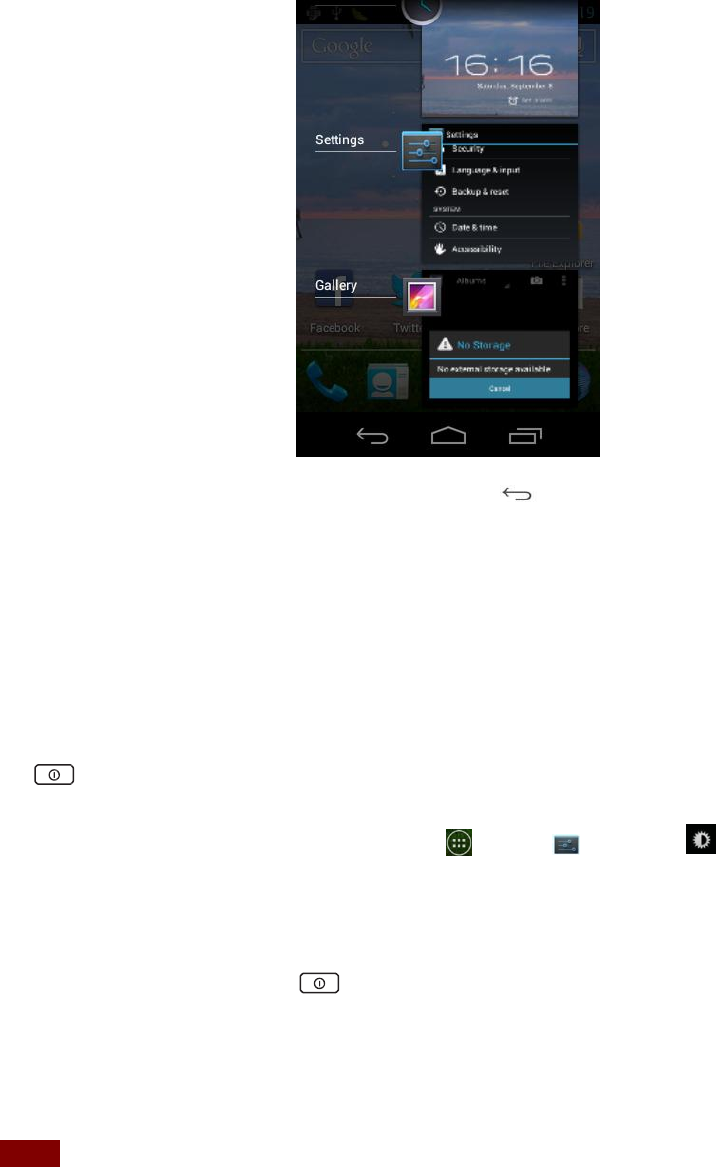
20
2. Tap an icon to open the application or press Back to return to your previous screen.
Sleep Mode
Sleep mode saves battery power by turning off your display. You will still receive messages and calls
when the display is turned off.
Switching to Sleep mode
Press Power/Lock to switch your phone to Sleep mode.
Your phone automatically turns off the display after a period of inactivity. To customize the screen
timeout settings, from the Home screen, tap Apps >Settings >Display >Sleep.
Waking up from Sleep mode
Your phone automatically wakes up when you have an incoming call.
To wake it up manually, press Power/Lock. You’ll need to unlock the screen as described below.
Unlocking the screen
On the lock screen, tap the unlock icon and slide your finger in the direction of the arrows to
unlock the screen. The screen unlocks automatically when you answer an incoming call.
NOTE If you have set up a screen unlock pattern, pin, or password, you will be asked to draw the pattern on the
screen or enter the PIN or password to access the phone software.

21
Activating Secure Screen Lock
1. From the Home screen, tap Apps >Settings.
2. Tap security >screen lock.
• If you have already configured the screen lock, tap Change screen lock to change how to
lock or unlock your screen.
3. Tap Pattern, PIN, Password, or Face Unlock. Then enter a custom pattern, PIN or password as
prompted.
• If you select ‘None’, screen unlock security is cancelled.

22
Adjusting Volume
Ringtone and Media volume are independent of each other and adjusted separately.
Adjusting the ringer volume
From the Home screen, press Volume up or Volume down on the right side of the phone to
adjust the ringer volume to your desired level.
• While in the lowest ringer volume level, press Volume down once to set your phone to
Vibrate mode. To set your phone to Silent mode, you can press Volume down once again.
• While in the Silent mode or Vibrate mode, press Volume up once to switch to ringtone mode.
Adjusting the media volume
While playing music, watching a video or using preloaded or downloaded games or applications,
press Volume up or Volume down on the right side of the phone to adjust the media volume.
Adjusting the earpiece volume for phone calls
During a phone call, press Volume up or Volume down.
Adjusting the volume via Settings menu
1. From the Home screen, tap Apps >Settings.
2. Tap Sound > Volumes.
3. Drag the volume sliders left or right to adjust your phone’s Ringtone, Media, and Alarm. Your
phone plays a sample tone at the selected volume level while you drag the slider.
NOTE If you uncheck the option to use call volume for notifications, you can set the notification ringtone volume
independently.
4. When you’re done, tap OK.
Searching Your Phone and the Web
The search key is a powerful part of the U675’s software and enables you to quickly locate files,
contacts, and applications. You can also search the web using your favorite web search service.
1. Tap Apps > Google.
2. Begin entering text, or tap a previously used search term.
• As you enter the text, matching items on your phone and suggestions from Google web search
will appear on the screen.
3. Tap a suggestion to go directly to that result.

23
Connecting Your Phone to a Computer
Copying files to/from the microSD card
You can copy your music, photos, and other files to the microSD card of your phone.
NOTE This option is available only when a microSD card is inserted into the slot of your phone. While your phone
is connected to a computer, USB Mass storage mode prevents you from using applications that access the
memory card.
1. Connect your phone to your computer using the supplied USB cable.
2. Open the Notifications panel >tap USB connected.
3. On your computer, the connected phone is recognized as a removable hard drive.
4. Navigate to the removable drive and open it.
5. Do one of the following:
• Copy the files from the computer to the microSD card’s root folder.
• Copy the files from the phone’s microSD card to a folder in your computer.
6. After copying the files, un-mount the removable drive (that is, your phone) as required by your
computer’s operating system to safely remove your phone.
7. After you have un-mounted the removable drive, you can disconnect the phone from the
computer.
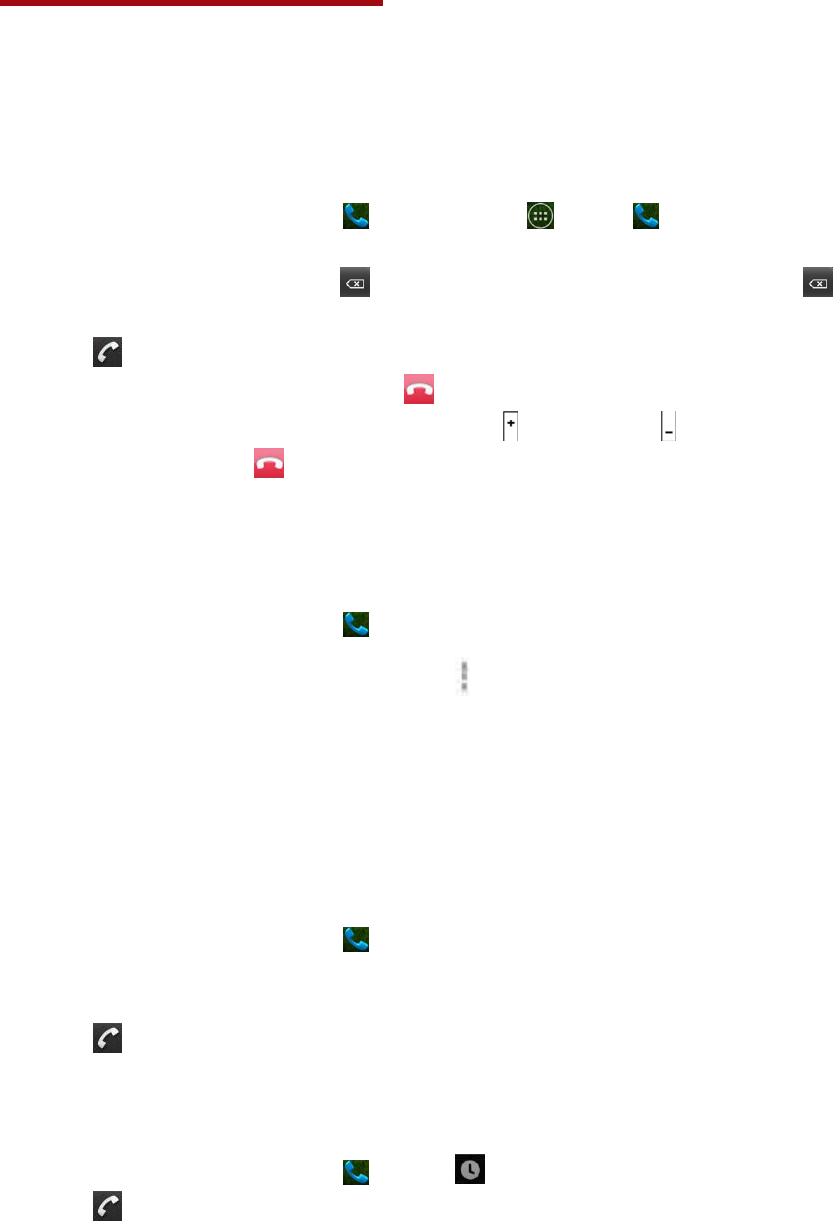
24
Phone Calls
Making Calls
The simplest way to make a call is to dial the number directly. You can also call numbers listed in
your call log or Contacts list.
Making a call from the dialer screen
1. From the Home screen, tap Phone. Or tap Apps >Phone.
2. Tap the number you want to dial.
• If you make a mistake, tap to erase a single character. Tap and hold to erase the entire
string.
3. Tap Dial.
• The Calling screen is shown and appears in the Status bar while the call is active.
• To change the volume during a call, press Volume up / Volume down.
4. To end the call, tap End Call.
Entering a Pause/Wait
Pause and wait options can help you dial additional numbers such as a voicemail password, or
phone banking system menus.
1. From the Home screen, tap Phone.
2. Tap the number you wish to dial > tap Option >Add 2-sec pause or Add wait.
• Add 2-sec pause: Your phone will wait for 2 seconds then continue to dial the remaining
numbers automatically.
• Add wait: Your phone will wait with the message, ‘Send the following tone?’ until Send is
tapped, then continue dialing the remaining numbers.
Making an international call
1. From the Home screen, tap Phone.
2. Tap and hold 0 until the international prefix ‘+’ appears.
3. Tap the country code, area code, and phone number.
4. Tap Dial.
Calling a number from the Call log
Your phone logs all incoming and outgoing calls.
1. From the Home screen, tap Phone >Call log.
2. Tap Dial at the right of any entry to dial.
• Calls are listed with the most recent at the top.

25
• Calls to the same phone number are grouped together.
• Scroll up or down to view additional entries in the log.
• If you want to edit a number before calling, tap and hold the desired number, and then tap
Menu >Edit number before call.
Making a call from the Contact list
1. From the Home screen, tap Phone > . Or tap Apps >People.
2. Scroll through the contact list.
• To find a specific contact, you can search by tapping Search. Enter the name of the contact
you’re searching for. As you type, contacts with matching names appear below the search box.
Or you can use the tab on the right hand side of the screen to scroll through the alphabetical
contacts.
3. Tap the contact you want to call.
4. Tap the phone or mobile number.
Making an emergency call
Your phone supports international emergency numbers such as 911. Emergency calling is
supported anywhere the phone has a network signal.
Making an emergency call
1. From the Home screen, tap Phone.
2. Tap the emergency number for your location. This is usually 911, *911 or #911.
3. Tap Dial.
4. To end the emergency call, tap End Call.
Making an emergency call while the phone is locked
1. When your phone is no service status, Emergency call button is displayed on the lock screen.
Tap Emergency call.
2. Tap the emergency number for your location. This is usually 911, *911 or #911.
3. Tap Dial.
4. To end the emergency call, tap End Call.
Answering or Rejecting Calls
When you receive a phone call, the screen displays the caller’s name, phone number, and caller ID
icon (if stored in Contacts). When you receive a phone call from a phone number not stored in
your Contacts, only the default caller ID icon and phone number are shown.
All incoming calls are recorded in the Call log. If you miss a call, you receive a reminder notification.
Answering or rejecting an incoming call
1. Drag the icon in the direction of the arrows to answer the call.
• If you were already in a call, the first call is placed on hold during answering the new call.
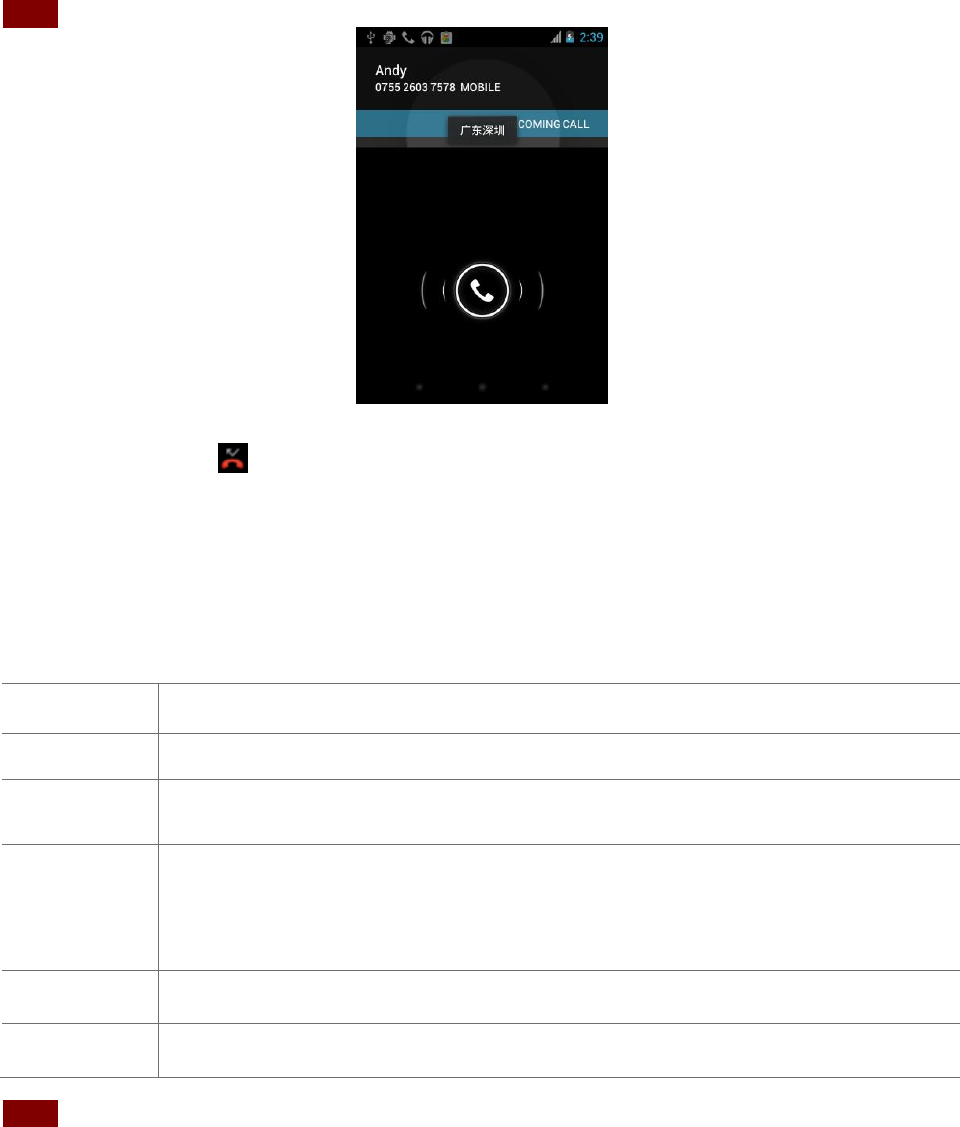
26
• To silence the ringer before answering the call, press either of the volume keys.
NOTE The caller you reject is sent directly to your voicemail box to leave a message.
Checking missed calls
• If you miss a call, is displayed in the Status bar.
• If you open the Notifications panel, you will see the number of missed calls. Tap the
notification to be taken to the call log and view detailed information.
Using In-Call Options
When a call is in progress, the following options are available:
Dial Pad
Tap Dial Pad to enter additional numbers during your call.
Mute
You can unmute the microphone by tapping Mute icon again.
Speaker
You can turn the speakerphone off by tapping the Speaker icon again.
The speaker is turned off automatically when your current call ends.
Bluetooth
When a Bluetooth device is paired and connected to your phone, you can
conduct all calls using Bluetooth for hands-free conversation. When using
Bluetooth headset during a call, the current call screen has a blue border and the
Ongoing Call icon turns blue in the Status bar.
Tap Bluetooth icon to toggle in-call audio to and from the Bluetooth accessory.
Contacts
You can search for contacts during a call.
Manage calls
You can switch between two calls by tapping Manage calls icon.
NOTE To avoid damaging your hearing, do not hold the phone up to your ear when the speakerphone is on.
Using Call Log
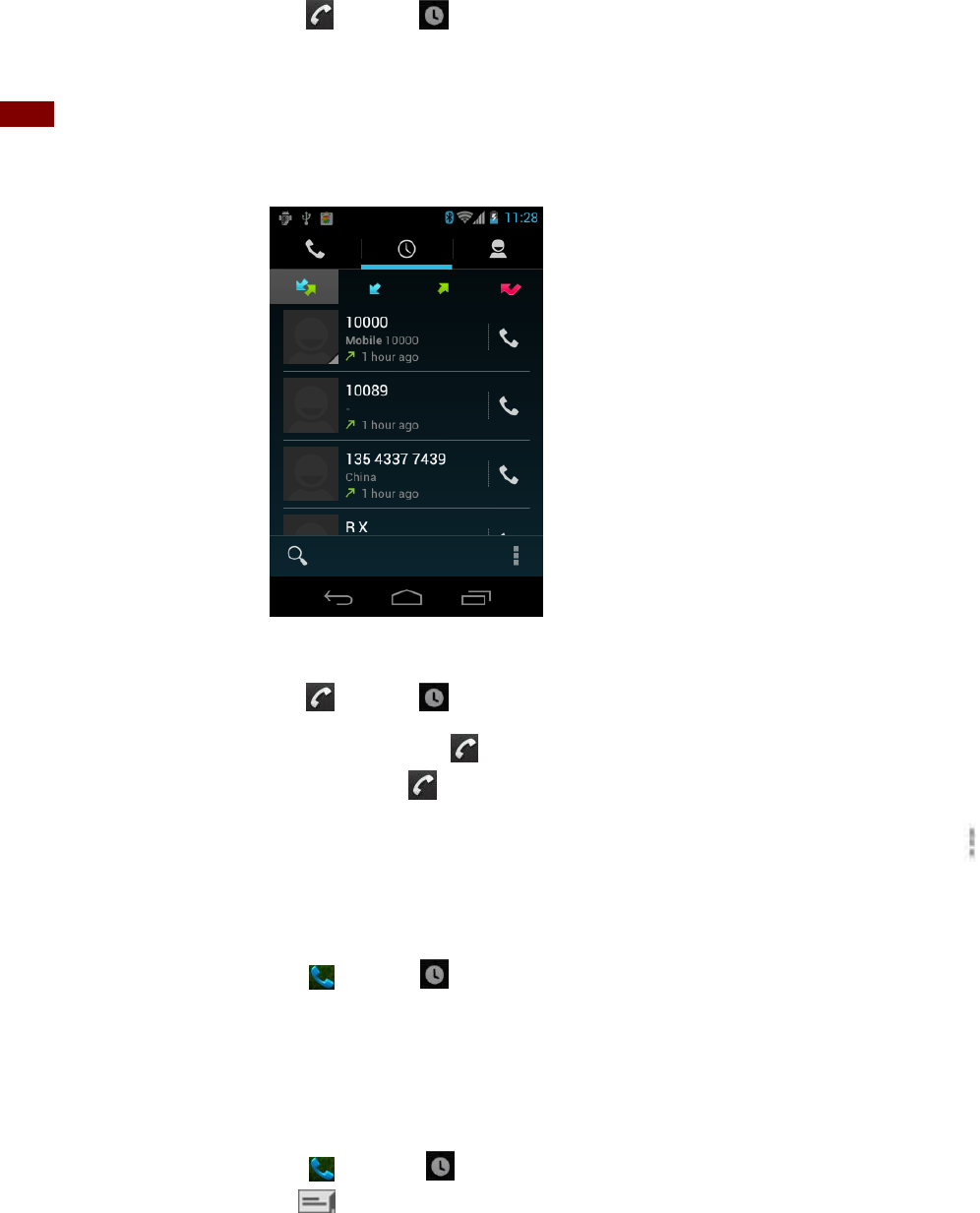
27
The phone stores the numbers of all incoming and outgoing calls in the Call log. The Call log
displays the details of the call including time, date, and duration.
Opening the Call log
1. From the Home screen, tap Phone >Call log.
• Calls are listed with the most recent at the top. Calls of the same phone number are
grouped together. Scroll to view earlier entries in the log.
NOTE You can tap and hold the desired number in the call log list to select options such as Call, View contact, Edit
number before call, Send text message, Add to contacts, Remove from call log.
Calling a number from the Call log
1. From the Home screen, tap Phone >Call log.
2. If you want to call a number directly, tap at the right
of the entry. Or, select a contact >tap Dial.
• If you want to edit a number before calling, tap and hold the desired entry, and then tap
Option >Edit number before call.
Adding a phone number from your Call log to your Contacts list
1. From the Home screen, tap Phone >Call log.
2. Tap and hold the desired entry >Add to contacts.
3. In the list of contacts that opens, tap Create new contact or add to an existing contact.
4. Tap Done.
Sending a text message from the Call log
1. From the Home screen, tap Phone > Call log.
2. Tap and hold the contact > Send text message.

28
3. Enter your message and tap to Send.
Clearing the Call log
1. From the Home screen, tap Phone >Call log.
2. Tap Option >Clear call log >OK.
• To remove just one entry from the Call log, tap and hold the entry. In the pop up menu, tap
Menu>Remove from call log.
Listening to Your Voicemail
Voicemail application is displayed only when phone calls are available. When you have a new
voicemail message, appears in the Status bar.
Calling your voicemail
1. From the Home screen, tap Apps >Voicemail.
Calling your voicemail from the Dial Pad
1. From the Home screen, tap Phone.
2. Tap and hold 1. Or tap 1 and tap Dial.
Calling your voicemail from the Notification panel
1. Open the Notifications panel and tap ” New voicemail”.
Using Voice Dialer
You can use the Voice Search application or Voice Dialer application to place a phone call by
speaking the name of a contact or a phone number.
1. From the Home screen, tap Apps > Voice Dialer.
• If you have a Bluetooth headset that supports “voice-recognition” or “voice-dialing,” you
may be able to open Voice Search by pressing and holding your headset’s main button and
dial by voice using your headset. For details, see your headset manual.
2. The Voice Dialer opens, listens for your spoken instructions, and displays some hints for how to
use it.
3. Say “Call” followed by the name of the contact to call.
• Or, follow one of the suggestions for dialing a number or controlling your phone in other ways.
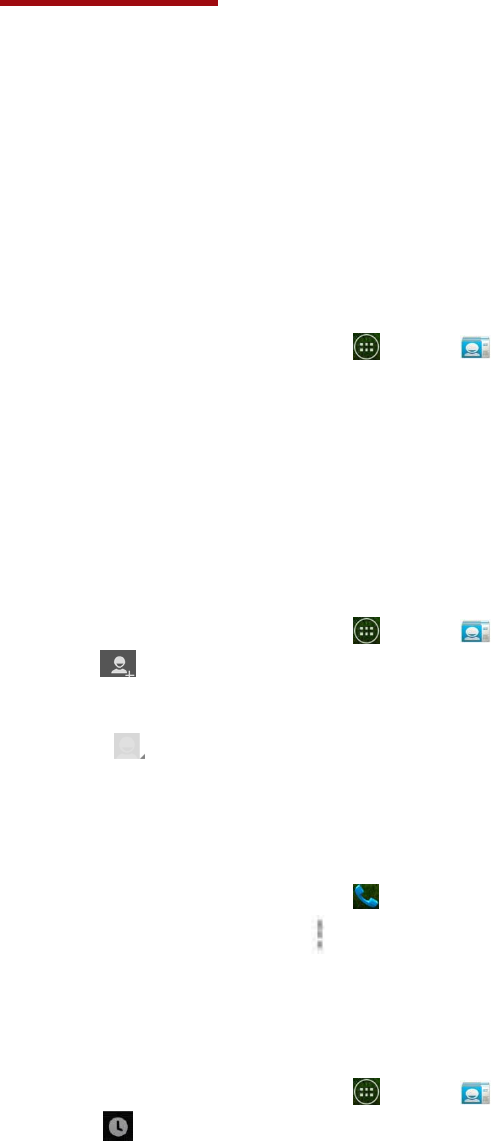
29
People
About People
People give you quick and easy access to the people you want to reach. Contacts from Google
accounts are also downloaded and synced with the Contact list.
You can manage your communications with your contacts via phone, messaging, and email
without the need to jump from one app to another.
Opening Your People
Open People to add, view, and communicate with your friends and acquaintances.
1. From the Home screen, tap Apps >People.
• All of your contacts are displayed alphabetically in a scrolling list.
• You can use the tab on the right hand side of the screen, or flick your finger up or down to
scroll quickly.
Getting Started
Adding a new contact
1. From the Home screen, tap Apps >People.
2. Tap .
3. If you have more than one account, select an account then enter the information for the contact.
• Tap > select Take photo or Select photo from Gallery to add a picture.
• Enter your contact’s information.
4. Tap Done.
Saving a phone number from the Dial Pad
1. From the Home screen, tap Phone.
2. Enter the number >Tap Option >Add to contacts.
3. Tap Create new contact or an existing contact.
4. Enter the information for the contact>tap Done.
Storing a contact using Call log
1. From the Home screen, tap Apps >People.
2. Tap Call log >tap the number you want to save >Add to contacts.
3. Tap Create new contact or select an existing contact.
4. If you have more than one account, tap the account where you want to save the contact >enter
the information for the contact > tap Done.

30
Importing / Exporting / Sharing contacts
Importing contacts from your microSD card
If you have contacts stored in vCard format on the microSD card, you can import them into Contacts
on your phone.
1. From the Home screen, tap Apps >People.
2. Tap Option >Import/Export.
3. Tap Import from storage.
4. If you have more than one account on your phone, select the desired account.
5. Tap the option to Import one vCard file, Import multiple vCard files or Import all vCard files
on the microSD card.
6. Tap OK to confirm. The contacts are imported.
Exporting contacts to your microSD card
1. From the Home screen, tap Apps >People.
2. Tap Option >Import/Export.
3. Tap Export to storage.
4. Tap OK to confirm.
• This process creates a file containing all your contacts with a .vcf extension on your microSD
card.
Sharing visible contacts
1. From the Home screen, tap Apps >People.
2. Tap Option >Import/Export.
3. Tap Share visible contacts > Select Bluetooth, Email, Gmail.
Viewing details about a contact
1. From the Home screen, tap Apps >People.
2. Tap the contact whose details you want to view.
3. Tap the communication icon to start dialing, texting, or emailing the contact.
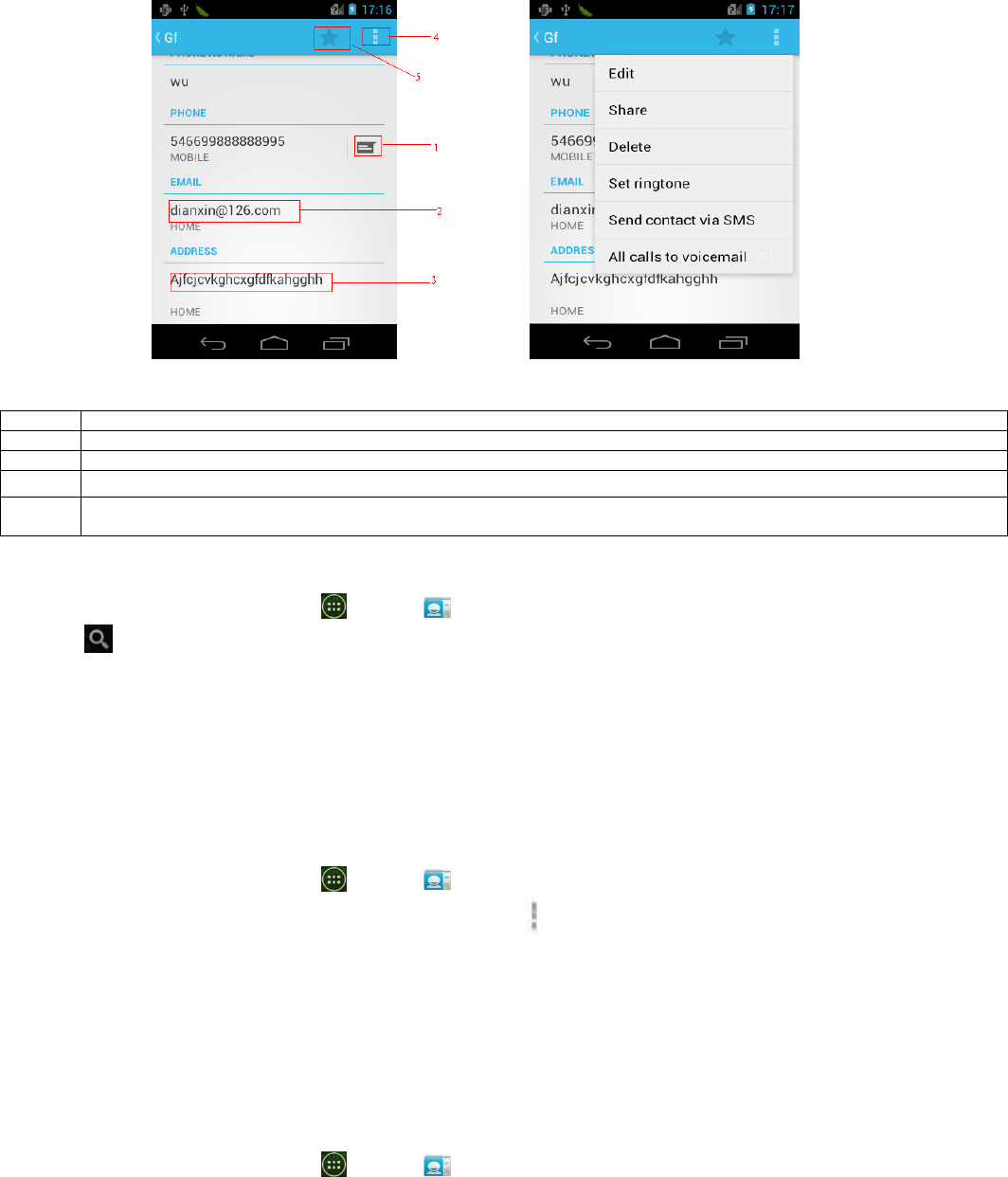
31
1
Tap to compose a text message.
2
Tap to send an email
3
Tap to view the address on Maps
4
Tap to edit, share, delete, set ringtone, send contacts via SMS, All calls to voice mail
5
Add to favorites: To remove a contact from your favorites list, tap the gold star again. The star turns gray and the contact is removed from
your favorites list.
Search for a contact
1. From the Home screen, tap Apps >People.
2. Tap Search.
3. Start entering the contact’s name.
As you type, contacts with matching names appear below the search box.
4. Tap the matching contact in the list to open.
Editing/Deleting Contacts
Editing contact details
1. From the Home screen, tap Apps >People.
2. Tap and hold the contact you want to edit > Tap Option >Tap Edit contact.
3. Edit the contact information.
4. Tap Done.
Setting a contact’s default phone number/email
Setting a contact’s default phone number
The default phone number is used when you initiate a call or text message by tapping and holding a
contact.
1. From the Home screen, tap Apps >People.
2. Find the desired contact > Tap and hold the phone number to designate it as the default phone
number.

32
3. Tap Set default.
• The default phone number is indicated with a checkmark.
Setting a contact’s default email
The default email is used when you send an email from the list by tapping and holding a contact.
1. From the Home screen, tap Apps >People.
2. Find the desired contact > Tap and hold the email address to designate it as the default email
address.
3. Tap Set default.
• The default email is indicated with a checkmark.
Setting a ringtone for a contact
1. From the Home screen, tap Apps >People.
2. Tap the desired contact.
3. Tap Option >Set ringtone.
• Tap a ringtone from the list to play when the contact calls. A sample of the ringtone is played.
4. Tap OK.
Adding a contact to your favorites
1. From the Home screen, tap Apps >People.
2. Tap and hold the desired contact >Tap .
• To remove a contact from your favorites list, tap People >tap and hold the contact >tap .
Joining contacts
1. From the Home screen, tap Apps >People.
2. Tap the contact you want to save. The others will merge into this file. This is the contact you
will see in contacts after joining.
3. Tap Option >Edit > Tap Option >Join.
4. Tap the contact you want to join with the first contact. The information from the second contact
is added to the first contact, and the second contact is hidden.
Separating contacts
1. From the Home screen, tap Apps >People.
2. Tap the contact you want to separate.
3. Tap Option >Edit > Tap Option >Separate >OK.
4. The contact information is split into separate contacts.
Deleting a contact
1. From the Home screen, tap Apps >People.

33
2. Tap the contact you want to delete, tap Option >Delete.
3. Tap OK.
Communicating
Sending text message
1. From the Home screen, tap Apps >People.
2. Tap and hold the contact you want to send >tap .
• The Primary Phone Number is used, or you are prompted to choose a phone number.
Making calls
1. From the Home screen, tap Apps >People.
2. Tap and hold the contact to call >tap the number.
• The Primary Phone Number is used, or you are prompted to choose a phone number.
Map of contacts
1. From the Home screen, tap Apps >People.
2. Tap the desired contact > tap the place icon of the address.
3. The mapping application will open.
Connecting by using Quick Contact
1. From the Home screen, tap Apps >People.
2. Tap the icon or photo next to your desired contact >tap the desired communication method.
• Only the icons relevant to your contact’s data are displayed.
• If there are too many icons to fit on the screen, drag to the left or right to select an icon.
Account Setting
Working with Google accounts

34
1. From the Home screen, tap Apps >People.
2. Tap Menu >Accounts.
• After registering your Google account, your online Google contacts are synchronized to your
phone. Changes made online or on the phone are automatically synchronized and updated
in both locations. This address book will be used throughout the user interface.
• If you register two or more accounts, you can merge address books from the multiple accounts
into one address book.
Contact List Display Options
1. From the Home screen, tap Apps >People.
2. Tap Option >Contacts to display.
• Only contacts with phones: Only contacts with phone numbers are shown in the contacts list.
• Sort list by: Select First name or Last name.
• View contact names as: Select First name first or Last name first.
• Choose contacts to display: Tap an account to open its list of groups. Check or uncheck the
groups you want to display in the contact list.
Messaging
About Messaging
Use Messaging to send text messages (SMS) and multimedia messages (MMS) to other mobile
phones and email addresses.
1. From the Home screen, tap Apps > Messaging.
On the Messaging screen, your sent and received messages are neatly grouped into conversations,
by contact names or phone number. You can:
• Scroll up or down the list of conversations by flicking your finger on the screen.
• Tap a contact name or number to view the conversation history.
• Tap the photo or to open additional menu options.
Sending Messages
Sending a Text Message
NOTE Depending on your billing plan, if you exceed the single text message character limit, you will be billed for
multiple messages.
1. From the Home screen, tap Apps > Messaging.
2. Tap Create New message.
3. Enter the phone number in the To field. Fill in one or more recipients. You can:
• Enter the first few letters of a contact name or phone number. Matching contacts are displayed.
Continue typing or tap a name or phone number from the search results.
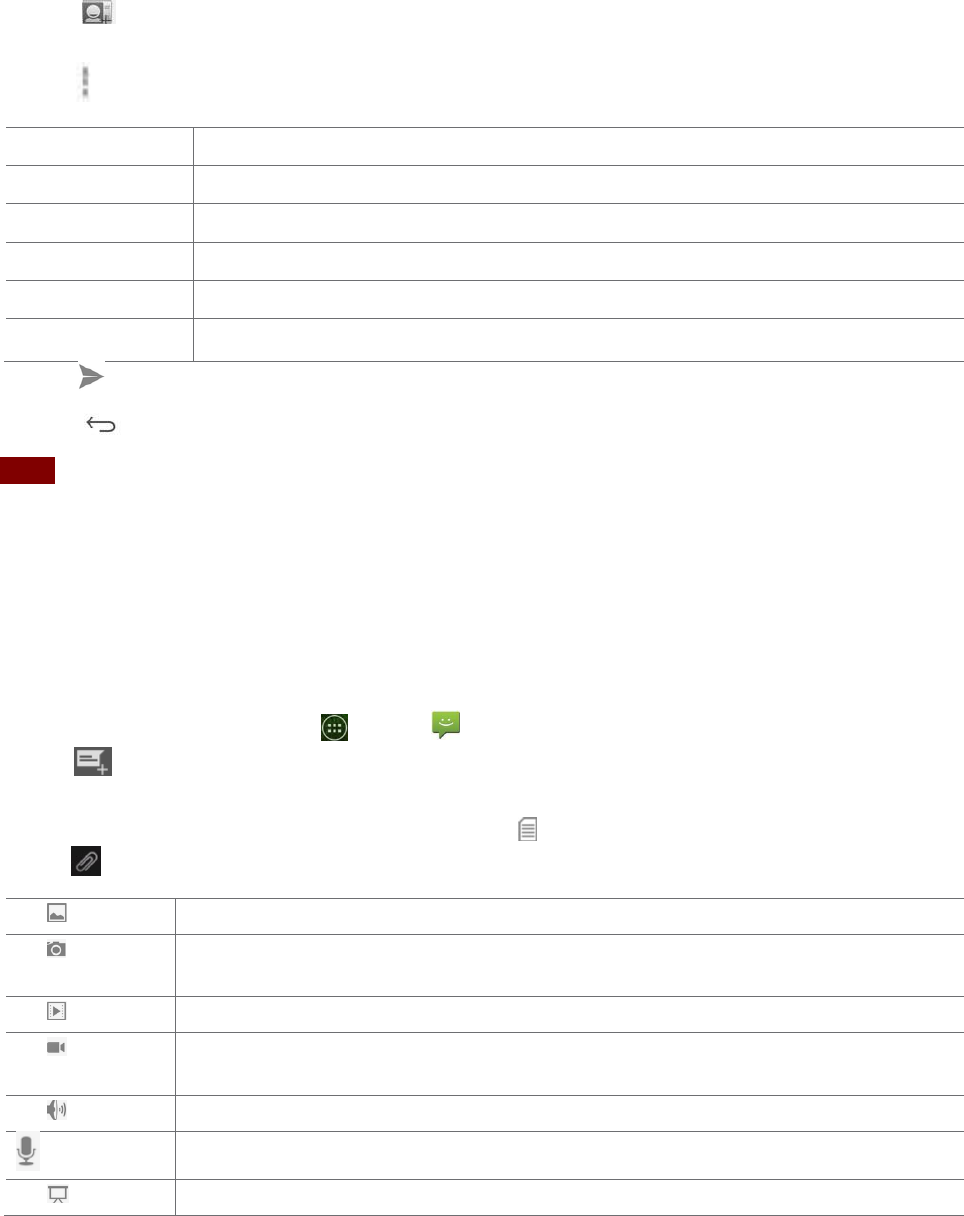
35
• Tap > Select message recipients from your contact list >Ok.
4. Tap Type message >enter your message.
• Tap Menu to see more options.
Add subject
Add subject.
Attach
Attach Media Files or a Slideshow within the message.
Send
Send the message.
Insert smiley
Insert a smiley in the message.
Discard
Delete the message in progress.
Import Temple
Some default text
5. Tap to Send.
• Tap Back to save the message as a draft.
NOTE Your text message automatically becomes a multimedia message on below condition:
• Compose a message over 160 characters
• Add subject
• Attach an item
Sending a multimedia message (MMS)
To compose a multimedia message, start by creating a new text message. Then simply add an
attachment.
1. From the Home screen, tap Apps > Messaging.
2. Tap Create New message.
3. Enter the phone number in the To field. Or select recipients from the contact list.
4. Tap Type message > enter your message. Tap to add the message template.
5. Tap Attach > choose the type of attachment.
Pictures
Select a photo.
Capture
picture
Capture a new photo.
Videos
Select a video.
Capture
video
Record a new video.
Audio
Select an audio file.
Record audio
Record a new audio file.
Slidesho
w
Create a slideshow from up to 10 of your photos.
6. From the message body, tap:
• View: To view the attached item.
• Replace: To change attached files.
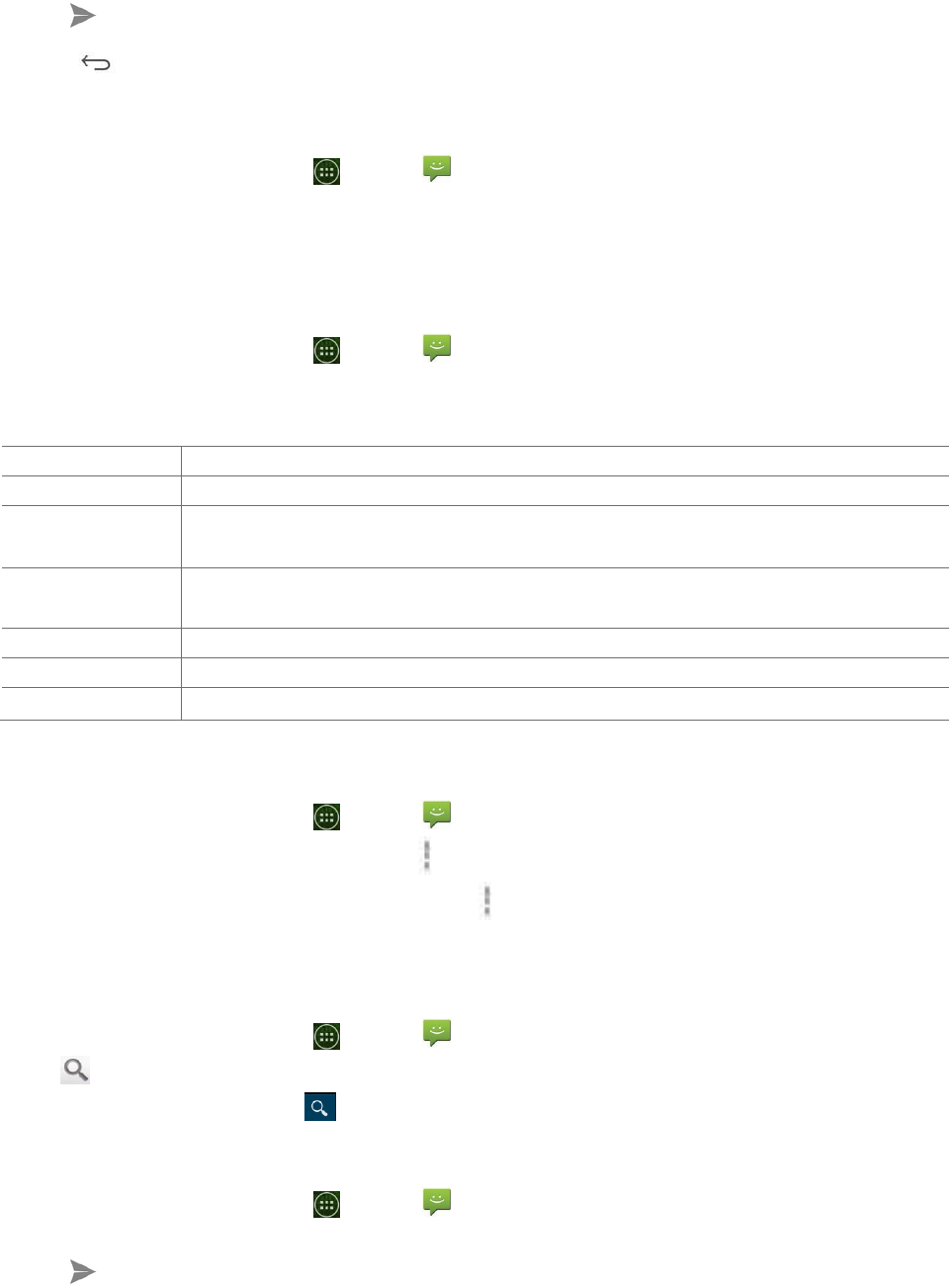
36
• Remove: To remove attached files.
7. Tap Send MMS.
• Tap Back to save it as a draft.
Resuming a draft message
1. From the Home screen, tap Apps > Messaging.
2. Tap the message indicated by “Draft” to resume editing.
3. When you finish editing, tap Send.
Reading Messages
1. From the Home screen, tap Apps > Messaging.
2. Tap a message thread.
3. Tap and hold an individual message to see more options.
Lock/Unlock
message
To lock/unlock a message.
Call ***
To call the message sender. (Only on incoming messages)
Add *** to
Contacts
To save the phone number or email address to Contacts. (Only on incoming
messages)
Forward
To forward a message. Enter a recipient, edit the content of the message as
needed >tap Send.
Copy message
text
To copy text from a message.
View message
details
To view details about a message.
Delete message
To delete a message.
Deleting a message thread
1. From the Home screen, tap Apps > Messaging.
2. Tap and hold the message thread, tap Option >Delete thread.
• If you want delete all message threads, tap Option >Delete all threads.
3. Tap Delete.
Searching messages
1. From the Home screen, tap Apps > Messaging.
2. Tap Search to search.
3. Enter the search term >tap Search.
Replying to a message
1. From the Home screen, tap Apps > Messaging.
2. Tap the received message > tap Type message > enter your message.
3. Tap Send.

37
Receiving Emergency Alerts Messages
Emergency Alerts service allows you to receive automatic alerts in times of crisis (e.g., earthquake,
hurricanes, etc.). Wireless Emergency Alerts (WEA), also known as CMAS, is a part of a national
alerting system called IPAWS (Integrated Public Alert and Warning System) that enables emergency
management officials to rapidly disseminate the warnings and safety information via text alerts to
wireless phones based on the phones’ geographic location, The Federal Emergency Management
Agency or FEMA is responsible for receiving the alerting information and forwarding the alerts to
participating wireless carriers such as Sprint. Such alerts may come from the President of the United
States; the National Weather Service, state or county public safety officials. This system is integrated
into the same national alerting services that serve television and radio today. For more information
regarding WEA/CMAS please go to: FEMA website.
http://www.fema.gov/emergency/ipaws/projects.shtm#6
Receiving Emergency Alerts Messages
1. From the Home screen, tap Apps > Messaging.
2. Tap Emergency alerts message you want to view. Emergency alert messages are indicated with
Emergency alert icon.
• If Emergency alert arrives on your phone during a call, is displayed in the Status bar. If
Presidential Emergency Alert, emergency alert icon will flashes. If non-Presidential,
Emergency alert icon is static icon.
• Only the Presidential Emergency Alert icon is displayed under the Time/Date on the
unlock/lock screen.
• If you are on an Emergency alert message screen in the Messaging application, the
following options are removed or disabled : Reply, Forward, and Call.
• If you have power cycled your phone and a Presidential Emergency Alert has not been viewed,
the Presidential Emergency Alert icon will continue to flash when the device is powered on
again.
Changing Messaging Settings
1. From the Home screen, tap Apps > Messaging.
2. Tap Option >Settings.

38
Storage settings
Delete old
messages
Check to delete older messages in a thread when messaging memory or
thread limits are reached. Uncheck to keep all messages. You may need to
manually delete messages if the messaging memory limit is reached.
Text message limit
Tap to set the number of messages to save per message thread. When the
limit is reached, older text messages are deleted if ‘Delete old messages’ is
checked.
Multimedia
message
limit
Tap to set the number of multimedia messages to save per message thread.
When the limit is reached, older multimedia messages are deleted if ‘Delete
old messages’ is checked.
Multimedia message (MMS) settings
Auto-retrieve
Uncheck to download only the heading of multimedia messages. You will
need to tap the MMS message heading and manually download each MMS
message. You may want to use this feature when roaming or when
connected to a slow data network.
Number of Retry
Attempts
Set number of retry attempts of download if multimedia message
download fails.
Notification settings
Notifications
Check to be notified in Status bar whenever you receive a new message.
Select ringtone
Select a ringtone to sound when you receive new message notifications.
Vibrate
Set the phone to vibrate every time you receive a new message notification,
only when silent mode, or never.
Receive Emergency Alerts
Emergency Alerts
This setting cannot be changed.
Presidential
Presidential Emergency Alerts are always displayed and this setting cannot
be changed.
Amber
Set to receive Amber Emergency Alerts.
–Extreme
Set to receive Extreme Emergency Alerts.
–Severe alerts
Set to receive Severe Emergency Alerts.
Emergency Alert
Test
Set to receive Emergency Alert Test message.

39
Google
Gmail
Opening your Inbox and Reading your Gmail
The inbox is your default Gmail view. All your received emails are delivered to your inbox.
1. From the Home screen, tap Apps >Gmail.
2. Tap the email you want to read.
• Tap to star the email.
• If the sender is a friend in Google Talk, you can see your friend’s online status.
• Tap Archive to archive the message.
• Tap Delete to delete the message from your inbox.
• Slid left and right to see the previous or next message in the list.
Replying to or forwarding an email message
1. From the Home screen, tap Apps >Gmail.
2. When reading a message:
• To reply to the sender, tap .
• To reply to all message recipients, tap Option > Reply all.
• To forward the message, tap Option > forward.
Sending a new email
1. From the Home screen, tap Apps >Gmail.
2. From any message list, tap .
3. Enter a name or address in the To field. To send the email to several recipients, separate
each email address with a comma.
4. Enter a subject in the Subject field.
5. Type the message text in the Compose Mail field.
• To attach an image file, Tap Option >Attach file>select the picture you want to attach.
6. Tap Send.
• To save the message as a draft, tap Option >Save draft.
Working with Multiple Email Messages
You can archive, delete or label groups of email messages at the same time.
1. From the Home screen, tap Apps > Gmail.

40
2. From any message list, check the box next to the email messages you want to work with.
Tap Archive to move messages out of your inbox without deleting. Archived emails are assigned
the All Mail label.
• Tap Delete to delete selected messages.
• Tap Labels > select the labels that you want to assign >tap OK.
Switching between Google accounts
If you have set up two or more Google Accounts on your phone, you can switch between them in
Gmail. Gmail displays only one Google Account at a time. The current account is shown at the top
right of any message list.
1. From the Home screen, tap Apps > Gmail.
2. From any message list, tap Option >Accounts.
3. Tap the account that you want to view. You can also tap the account name at the top of the
screen to see a list of your accounts.
Labeling email messages
You can organize your emails by label. Gmail has preset labels. Or you can create your own labels in
Gmail when viewed on a computer. (Note: Custom label colors created on the web are not
supported on your phone).
Labeling an email
1. From the Home screen, tap Apps > Gmail.
2. When reading a message, tap >Change labels.
3. Select a label > tap OK.
Viewing emails by label
1. From the Home screen, tap Apps > Gmail.
2. From any message list, tap >Go to labels.
3. Tap a label to view matching email messages.
Starring/un-starring an email message
You can star an important email to make it easy to find again. Starred emails are assigned the Starred
labels.
1. From the Home screen, tap Apps > Gmail.
2. From any message list:
• Tap to star a message.
• Tap to un-star a message.
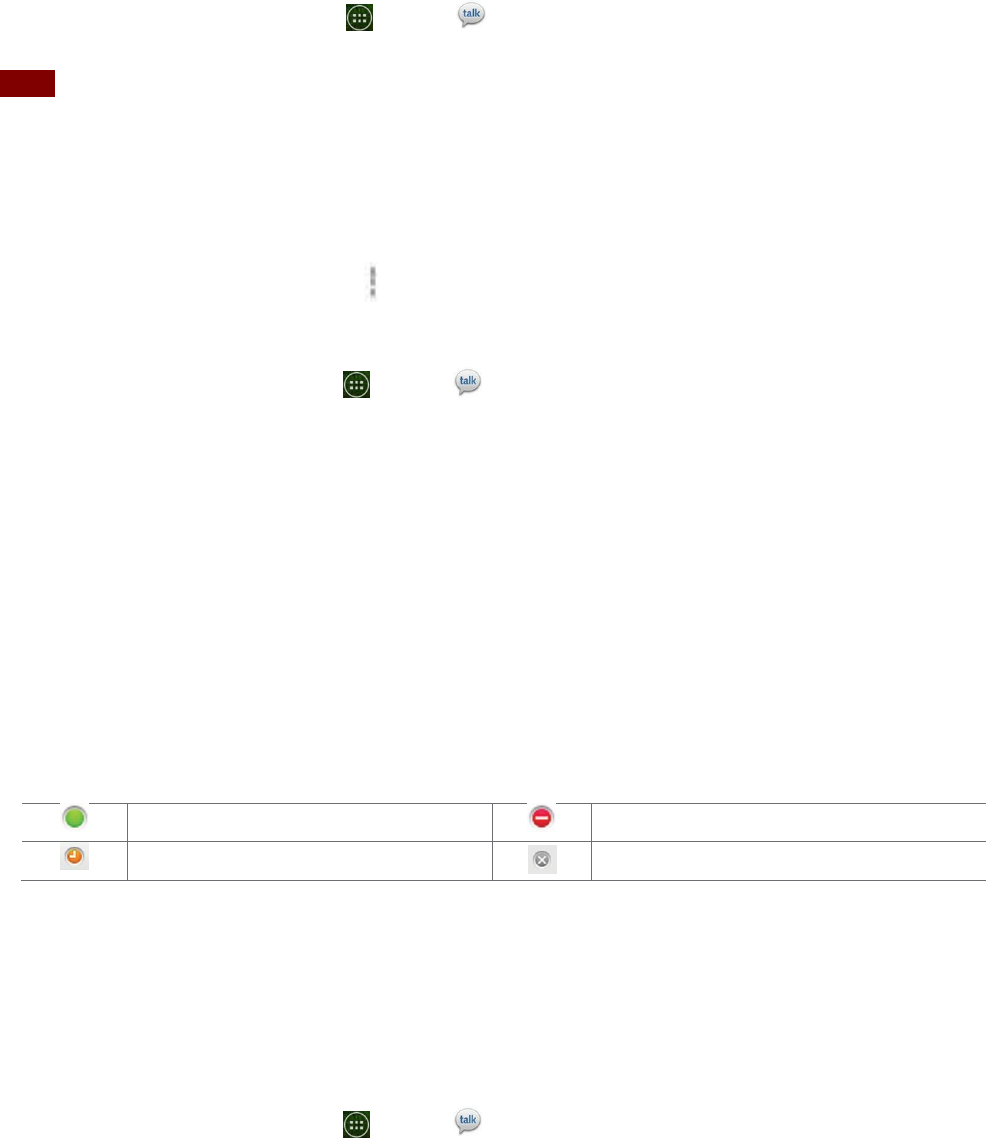
41
Google Talk
Use Google Talk to send instant messages to other Google Talk users anywhere they are logged in.
Signing in or out of Talk
Opening Talk and Signing in
1. From the Home screen, tap Apps > Talk. When you first open Talk, your friends list is
displayed.
NOTE When you first turn on your phone and sign in to your Google Account, you are automatically signed in to
Google Talk. You will remain signed in, even while you’re using other applications, until you deliberately
sign out.
Talk syncs data only from the first Google Account you added to your phone.
Signing out of Talk
1. From the Talk friends list, tap Option >Sign out.
Updating Your Online Status, Profile Picture, and Status Message
1. From the Home screen, tap Apps > Talk.
2. Tap your name at the top of the Talk friends list.
• Tap your picture >Remove to delete the image or Change to select another picture from your
microSD card.
• Tap the online status bar > select your online status: Available, Busy, or Invisible.
• Enter a new status message.
3. Tap Done.
Your picture, online status, and message will be updated anywhere your Talk status is displayed.
Adding and managing friends list
Online Status Indicators
Available
Busy
Away
Offline
Monitoring online status
The Talk friends list is sorted by online status: active chats, online, away, busy, and offline. Within
each status group, friends are listed alphabetically. Icons in Talk, Gmail, Maps, and other
applications indicate Talk status.
Adding a friend to your friends list
1. From the Home screen, tap Apps > Talk.

42
2. Tap Option >Add friend.
3. Enter a Google Talk ID or a Gmail address >Send invitation.
When your friend accepts the invitation, the friend is added to your Talk contacts list. To view a list
of pending invitations to friends, tap Option >More >Invites.
Accepting chat invitations
When you are added to a friend’s Talk contact list, you will receive a notification and an invitation
appears in your friends list.
1. From the Home screen, tap Apps > Talk.
2. From the Talk friends list, tap Chat invitation.
• Tap Accept to accept the invitation. The friend is added to your friend list.
• Tap Cancel if you don’t want to chat or share your Talk status with the sender.
• Tap Block to block and add the sender to your blocked users list.
Viewing all friends or most popular friends
1. From the Home screen, tap Apps > Talk.
• Tap Option >All friends to view all your friends.
• When viewing All friends, tap Option >Most popular to view only friends that you often
chat with.
Managing a friend
1. From the Home screen, tap Apps > Talk.
2. Tap and hold a friend’s name to see more options (Start chat/Go to chat/ End chat, Friend info,
Block friend, Remove friend, View contact, always show friend/Auto show friend, Hide
friend).
NOTE Block friend: This option will block a user from sending you messages and add the user to your blocked friends
list. Always show friend: This setting will add the friend to your Most popular list. To remove a friend from
the Most popular list, tap and hold the friend’s name then tap “Auto show friend”.
Chatting with friends
Chatting with a friend
1. From the Home screen, tap Apps > Talk.
2. Tap an online friend.
3. Enter your message in the text box >Send.
Accepting an invitation to chat

43
When a friend sends you a Talk message, you receive a notification. There are 2 ways to respond:
• On your friends list, tap the friend who sent you the chat invitation or
• Open the notifications panel and tap the chat notification.
Adding another friend to your chat
1. When you’re chatting with a friend tap Option >Add to chat.
2. Tap a friend to invite.
This will start a new group chat for all parties. Only those who accept the new chat invitation will
be joined to the group chat.
Switching between active chats
You can switch between multiple active chats.
1. When you’re chatting with a friend:
• tap Option >Switch chats > tap the desired active chat.
• Or swipe left or right across the screen to switch between chats.
On the record or off the record your chats
You can make your chats on the record or off the record.
1. When you’re chatting with a friend:
• tap Option >Chat on record.
• Or tap Option >Chat off record to make your chats off the record.
Ending your current chat
1. From the Home screen, tap Apps > Talk.
2. From any chat window, tap Option >End chat.
Talk settings
1. From the Home screen, tap Apps > Talk.
2. Tap Option >Settings.
General settings
Automatically
sign in
Automatically sign in to Talk when you turn your phone on.
Mobile indicator
When selected, your status will indicate you are using Talk
on your mobile phone.
Automatic away-
status
Set your status to away when your phone’s display is off.
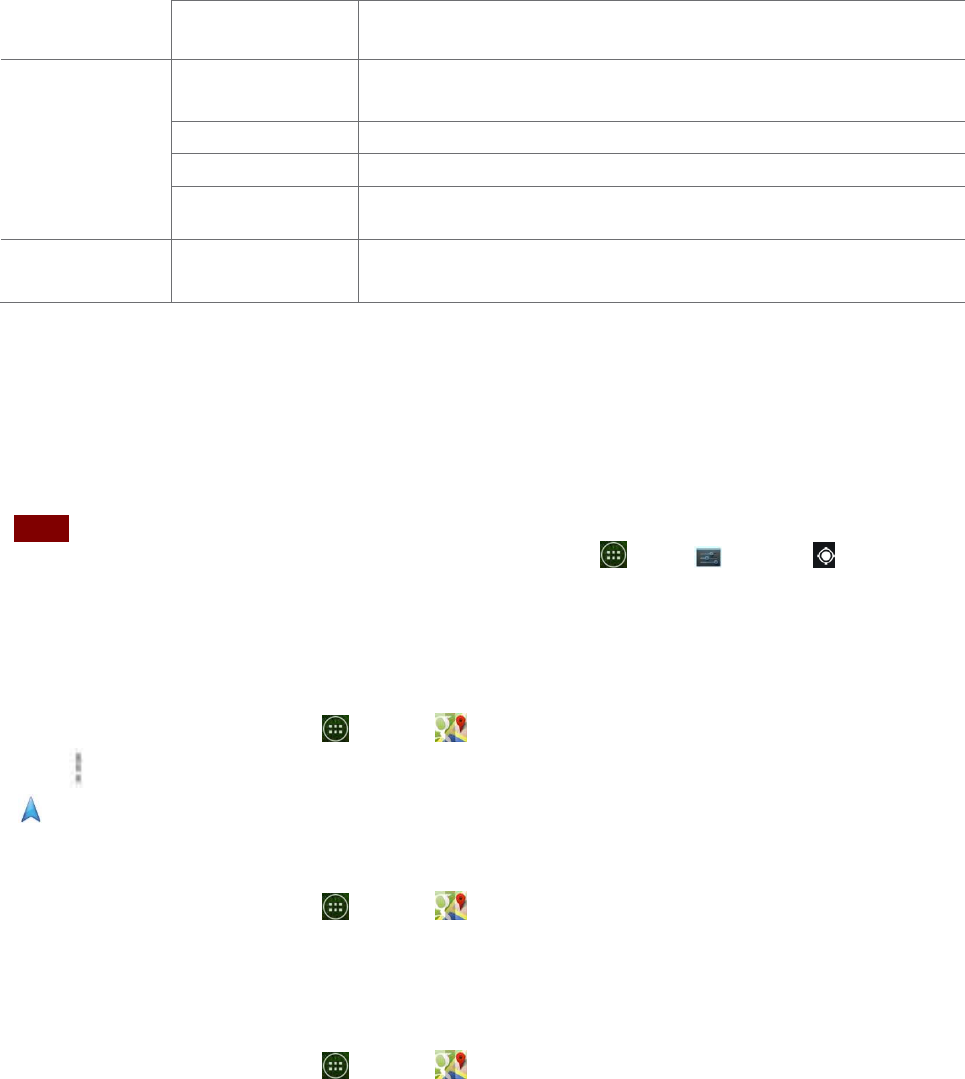
44
Clear search
history
Clear previous Talk chat searches from showing up in the
Search box.
Notification
settings
IM notifications
Show a notification icon in Status bar when you have a new
message.
Select ringtone
Select the Talk Notification ringtone.
Vibrate
Set to vibrate the phone when a new Talk message arrives.
Invitation
notifications
Notify in Status bar when friend invitations are received.
About
Terms & privacy
Read detailed Google Talk legal Terms and privacy
statements.
Maps
Use Maps to find your current location and get directions. You can search for addresses, landmarks
and businesses directly on a street map or satellite image.
NOTE You need an active mobile data or Wi-Fi connection to use Maps. To see your location and get directions, you
must turn on location services. From the Home screen, tap Apps >Settings >Location services.
Select one or both from Use wireless networks or Use GPS satellites. Maps may not be available for all
locations.
Opening and viewing Maps
Viewing your location
1. From the Home screen, tap Apps > Maps.
2. Tap Option >My Location.
Shows your location on the map and points north for your reference.
Using Maps
1. From the Home screen, tap Apps > Maps.
2. While viewing a map, swipe to any direction on the screen.
Viewing location details
Viewing information for a location
1. From the Home screen, tap Apps > Maps.
2. While viewing a map, tap and hold a location, starred place, or a search result on the map.
• A balloon opens over the location, with summary information.
3. Tap the balloon to see the address or more information.
Starring or un-starring a location
Add a Star to bookmark and easily return to a map location.
1. While viewing detail information for a location,
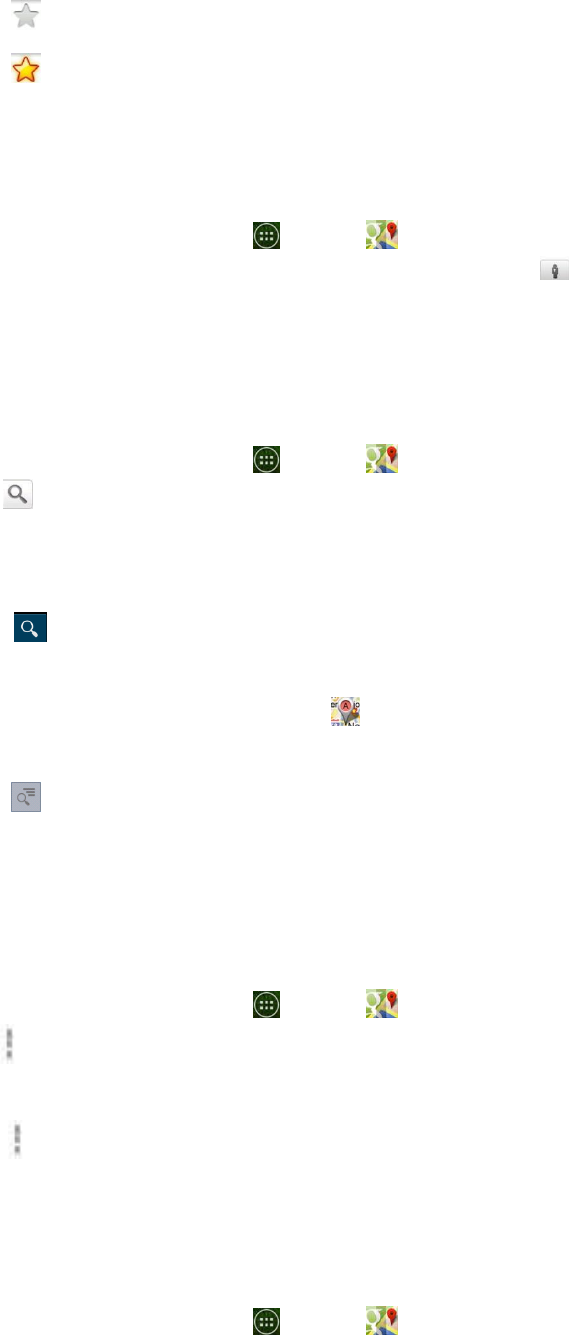
45
• Tap to star the location.
• Tap to un-star the location.
Viewing a location in Street view
Street view mode provides a street-level view of the location. Street view may not be available for all
areas.
1. From the Home screen, tap Apps > Maps.
2. While viewing detailed information for a location, tap .
• To view surrounding areas, swipe the screen in any direction.
Searching for a location
You can search Google Maps for specific locations, company names, or business types.
1. From the Home screen, tap Apps > Maps.
2. Tap Search.
3. Enter the search criteria. As you type, suggested matches from your contacts, the web, and
previously searched items are displayed.
• Tap to search
• Tap a suggested search term.
4. The search results are displayed as markers with letter labels on the map.
• Tap markers and titles to view more information.
• Tap to show the search results as a list >tap each item to see more information.
Viewing map layers
Initially, Google Maps opens with a street map. You can view additional map layers, such as
satellite images and traffic information. You can also view custom Web created Google Maps.
1. From the Home screen, tap Apps > Maps.
2. Tap Option >Layers. A dialog opens with a list of layers.
3. Turn layers on or off by tapping the layer name. A check mark indicates the layer is selected.
• Tap Option > Clear Map to deselect all layers.
Layers may change the map entirely or overlay additional information.Tap icons or interactive items
to explore different layer types.
Getting directions
1. From the Home screen, tap Apps > Maps.

46
2. Tap >Directions.
3. Use your current location as the starting point, or enter a location in the Start point field.
4. Enter your destination in the End point field.
5. Tap or or to select your transportation method > tap Get directions.
Local
Use Google Places to explore your current location.
NOTE You need an active mobile data or Wi-Fi connection to use Places. To see your location and get directions, you
must turn on location services. From the Home screen, tap Apps >Settings >Location services.
Select one or both from Use wireless networks or Use GPS satellites. Maps may not be available for all
locations.
Searching
1. From the Home screen, tap Apps >Local.
2. From the Places categories:
• Tap the Search field on top of the screen >enter the place you want to search >tap . To
narrow your results, select a category before searching.
3. The search results display in a list, with their approximate distance and direction.
• Tap to see your results on a map.
• Tap Option >Settings.
Labs settings
Measure
Tap the button to start and stop measuring
Bigger text
Use increase the text size of labels on the map
Insersection
Explorer
Enables blind and low-vision users to explorer a given
neighborhood from the comfort of their home
Display
Zoom Buttons
Use show zoom buttons on map
Scale Bar
Use show scale bar on map
Bubble action
Show “Get directions” button on bubbles
Offline and cache
Automatic caching
Use choose when automatic caching
Clear all map tiles
Use clear offline areas and cached ties
Location settings
Report from this
device
Use automatically update your location from your device
Manage your
friends
Use add or remove friends who can see your location
About settings
About
You can see many information about the map

47
Navigation
Navigation is an internet-connected GPS navigation system with voice guidance. Navigation
provides both spoken and on-screen turn-by-turn driving directions.
NOTE You need an active mobile data or Wi-Fi connection to use navigation. To see your location and get directions,
you must turn on location services. From the Home screen, tap Apps >Settings >Location services.
Select one or both from Use wireless networks or Use GPS satellites. Maps may not be available for all
locations.
Opening & Using Navigation
There are many ways to view the map and travel progress while in Navigation mode. See the
“Changing Views” section below for more information.
Navigating with Turn by Turn Directions
1. From the Home screen, tap Apps > Navigation or tap when viewing driving directions
in Google Maps.
2. Customize your navigation settings for highways or tolls by tapping .
• Tap Map to begin tracking your journey, even if you haven’t chosen a destination.
3. From the list of destination options:
• Tap Speak Destination to search the destination with voice.
• Tap Type Destination to enter the destination.
• Tap Contacts to use a contact’s address information.
• Tap Starred Places to select the destination from starred places.
• Tap a recent destination to select the previous destination.
A map opens with your route drawn in blue. Specific instructions are listed at the top of the screen.
As you navigate your route, each direction is spoken in turn, and the next turn is displayed. Your
current location is shown as a blue arrow on the map, which is updated as you navigate your route.
Google Navigation downloads and temporarily stores a copy of the directions and other
information about your route on the phone, so if you lose your connection to a data network, you
can still navigate to your destination.
You can control the volume of the spoken instructions with Volume up / Volume down. To turn
off the spoken directions, tap Option and Mute.

48
Previewing your route
1. From an active navigation, tap the directional instruction banner at the top of the screen.
2. Tap or to preview the next or previous segment of your route.
When you preview a route, tap to switch to the street-level view of your route.
Changing views of your route
You can view your progress on your route as a map with different informational layers. Zoom
in and out or drag to view adjacent areas. You can also view your progress in Satellite or
Street View.
1. While viewing an active navigation:
• Tap Option >Layers to switch to views traffic or a Satellite View, or to show the locations of
parking, restaurants, and other landmarks along your route.
• Tap Option >Route Info for a high-level summary of your route, with options to pick a
new route, see traffic information, and more.
Tap while on the Route Info screen to view each turn as a scrolling list of written directions.
• Drag the map to view adjacent areas, or tap the map to see controls for zooming in and out.
Finding an alternate route
If traffic is slow on your current route, or if you just want to try a different route, you can request
an alternate route from the Google Maps Navigation service.
1. From an active navigation:
• Tap Option >Route Info > .
• Select the alternate route you’d like to use to resume turn-by-turn guidance.
Exiting Navigation
You can exit Navigation mode when you reach your destination.
Latitude
Latitude allows you to share your location with friends and view their locations on a map.
Your location is not shared automatically. You must join Latitude, and then invite your friends to
view your location or accept their invitations. Only friends that you have explicitly invited or
accepted can see your location.
NOTE You need an active mobile data or Wi-Fi connection to use latitude. To see your location and get directions,
you must turn on location services. From the Home screen, tap Apps >Settings >Location services.
Select one or both from Use wireless networks or Use GPS satellites. Maps may not be available for all
locations.

49
Joining and opening Latitude
1. From the Home screen, tap Apps > Latitude.
2. The first time you join Latitude, you’re prompted to accept or reject the Google privacy policy.
Adding friends
Add friends to Latitude to share your location with them and request to see their location.
Only friends you have explicitly invited or accepted can see your location within Latitude.
Inviting friends
1. From the Home screen, tap Apps > Latitude.
2. Tap FRIENDS LIST>tap
• Tap Select from Contacts >select contacts to invite > when asked to confirm, Yes.
• Or tap Add via email address > enter one or more email addresses, separated by “,”>Add
friends >when asked to confirm, Yes.
If your friends are current Latitude users, they will appear at the top of your Google Contacts lists
with a Latitude icon. Current users will receive email request and a request within Latitude. If your
friends aren’t using Latitude, they’ll receive a location request email, but they must sign into
Latitude with a supported Google account before they can accept your request. If you invite a
friend who is not using a Google ID, you or your friends will need to re-send any location requests
once they have signed into Latitude with a supported Google account.
Responding to an invitation
1. From the Home screen, tap Apps > Latitude.
2. Tap New sharing request.
• Tap Accept and share back to share locations between you and your friend.
• Tap Accept, but hide my location to see the friend’s location, and hide your location.
• Tap Don’t accept to reject the request.
Viewing friends’ locations and managing friends
You can view your friends’ locations on a map or in a list.
• When you open Latitude, you are shown list of your Latitude friends with location summaries.
• When you open Maps, your friends’ locations are shown. Each friend is represented by a
photo and arrow indicating their approximate location. If a friend has chosen to share only
city-level location details, the friend’s photo is shown in the friend’s city center location.
Viewing friends’ profile
• While using Map mode, tap the friend’s photo. Your friend’s name appears in a balloon. Tap
the balloon.
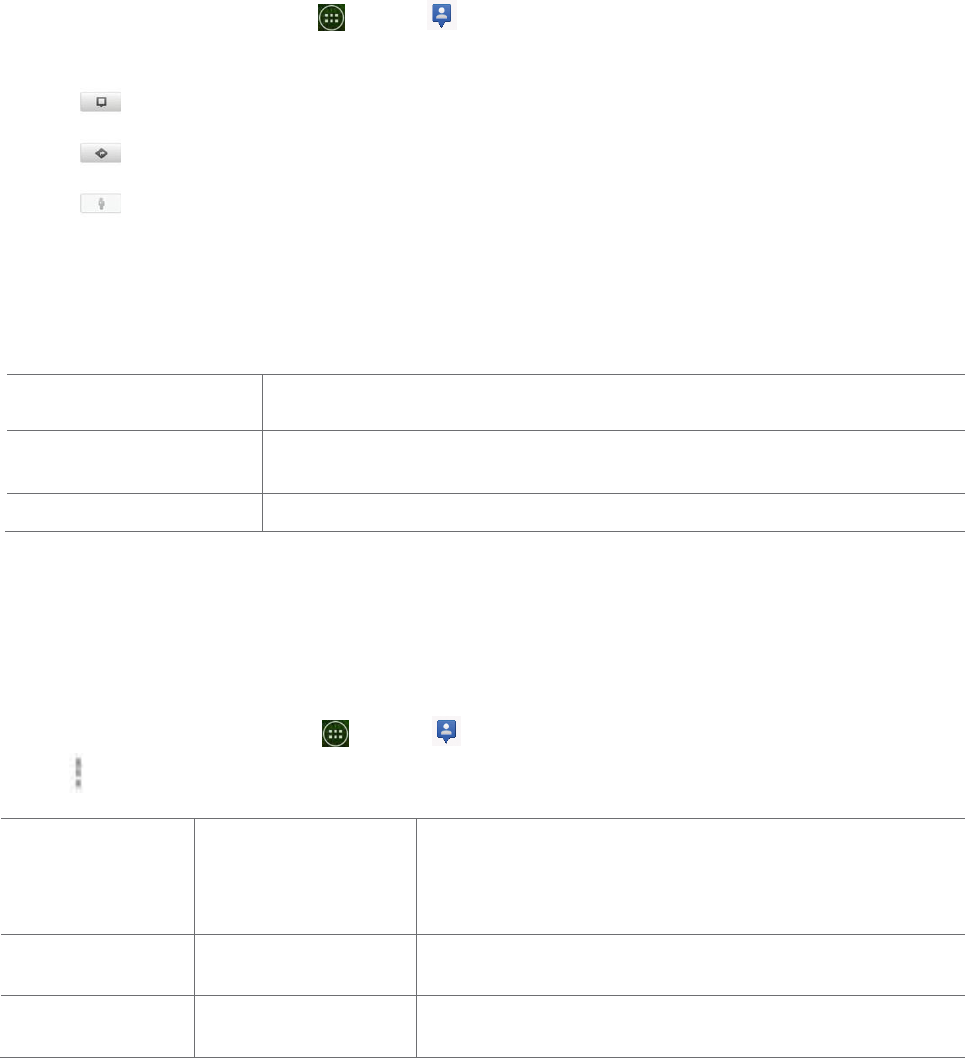
50
• From the Latitude friend’s list, tap a friend.
Managing friends’ communication and privacy options
1. From the Home screen, tap Apps > Latitude.
2. From a friend’s profile:
• Tap to view the friend’s location on the map.
• Tap to get directions to the friend’s location.
• Tap to view the friend’s location in street view.
• Tap the friend’s photo to open Quick contact where you can view contact details, send an email,
and more.
• Tap Sharing options to change sharing options for the friend.
Share best available
location
Share your precise location information.
Share only city level
location
Share only your city location, not a street-level location. Your friend
will see your picture in the middle of your current city.
Hide from this friend
Stop sharing your location with this friend.
• Tap Remove this friend to remove the friend from your list and stop sharing locations.
Privacy settings
Only the last location sent to Latitude is stored by Google. If you turn off Latitude or are hiding,
no location is stored. To change your privacy settings:
1. From the Home screen, tap Apps > Latitude.
2. Tap Option >Latitude settings.
Location reporting
Report from this
device
Use automatically update your location from this
device
Location history
Enable location
history
Store your past locations and visualize them on the
Latitude website.
Latitude location
sharing
Manage your friends
Add or remove friends who can see your location
Calendar
The Calendar application data on your phone syncs with the web-based Google Calendar service. It
is also compatible with Microsoft Exchange ActiveSync Calendar.

51
Opening Calendar
1. From the Home screen, tap Apps > Calendar.
Events are color coded to enable you to distinguish between multiple calendars. Events times are
shown using your local time zone, which is provided by your active mobile network. When
traveling, you may want to set a home time zone in Calendar.
Creating an event
Events created on your phone will be synced to Google Calendar or Microsoft Exchange
automatically.
1. From the Home screen, tap Apps >Calendar.
2. There are two ways to create an event:
• Tap Option >New event.
• In Day, Week, or Month view, tap and hold the screen at the date and/or time you want >New
event.
3. Enter the name, time, location, description, and optional additional details for your event.
• If you have more than one calendar, choose the calendar to which to add the event.
• In the Guests field, enter email addresses of anyone you want to invite. Separate multiple
addresses with commas (,). If your invitees use Google Calendar, they’ll receive an invitation
in Calendar and by email.
• If the event occurs on a regular basis, tap the Repetition box and choose the reoccurrence
information.
• You can set multiple reminders for an event.
3. Tap Done.
Viewing calendar and events
Changing calendar view
When you open Calendar, Month view is shown by default. You can also view the Calendar by
Agenda, Day, or Week.
1. From the Home screen, tap Apps > Calendar.
2. Tap Option > Settings >General settings choose the type of view that you want

52
Day Displays a chart of the events of one day, in a table of one-hour rows. All-day and
multiday events are displayed at the top. Each event is displayed at the
corresponding time. Swipe left or right to change dates, and swipe up or down to
view earlier or later times.
Week Displays one week calendar. All-day and multiday events are displayed at the top.
Swipe left or right to change weeks, and swipe up or down to view earlier or later
times.
Month
Displays a chart of the events of the month. Events are shown as blue bars on each
calendar date. Swipe left or right to change months.
Agenda
A list of your events in chronological order. All-day and multiday events are
listed at the start of each day. Days without events are not shown. Flick up or
down to view earlier or later events.
Today
Displays a chart of the events of today.
Option
You can select New event, Calendars or Settings.
Viewing event details
• In Day, Week, or Agenda view, tap an event.
• In Month view, tap a day to switch to Day view > tap an event.
Editing or deleting an event
1. In event details view, press the event > Edit event to edit the event.
2. Make your changes to the event > tap Done.
• To delete the event, press the event > Delete event > tap OK.
Synchronizing and displaying calendars
You can select which calendars to show or hide on your phone’s Calendar, and which ones to
synchronize.
1. From the Home screen, tap Apps >Calendar.
2. Tap Option >Calendars to display.
All the calendars you’ve added or subscribed to are displayed. (Calendars for accounts you’ve
configured not to synchronize are not included in the list.)
3. Tap the icon next to a calendar to change storage and visibility settings.
Calendar events stored on phone and visible in Calendar
Calendar events stored on phone but not visible in Calendar
Calendar events not synchronized to phone
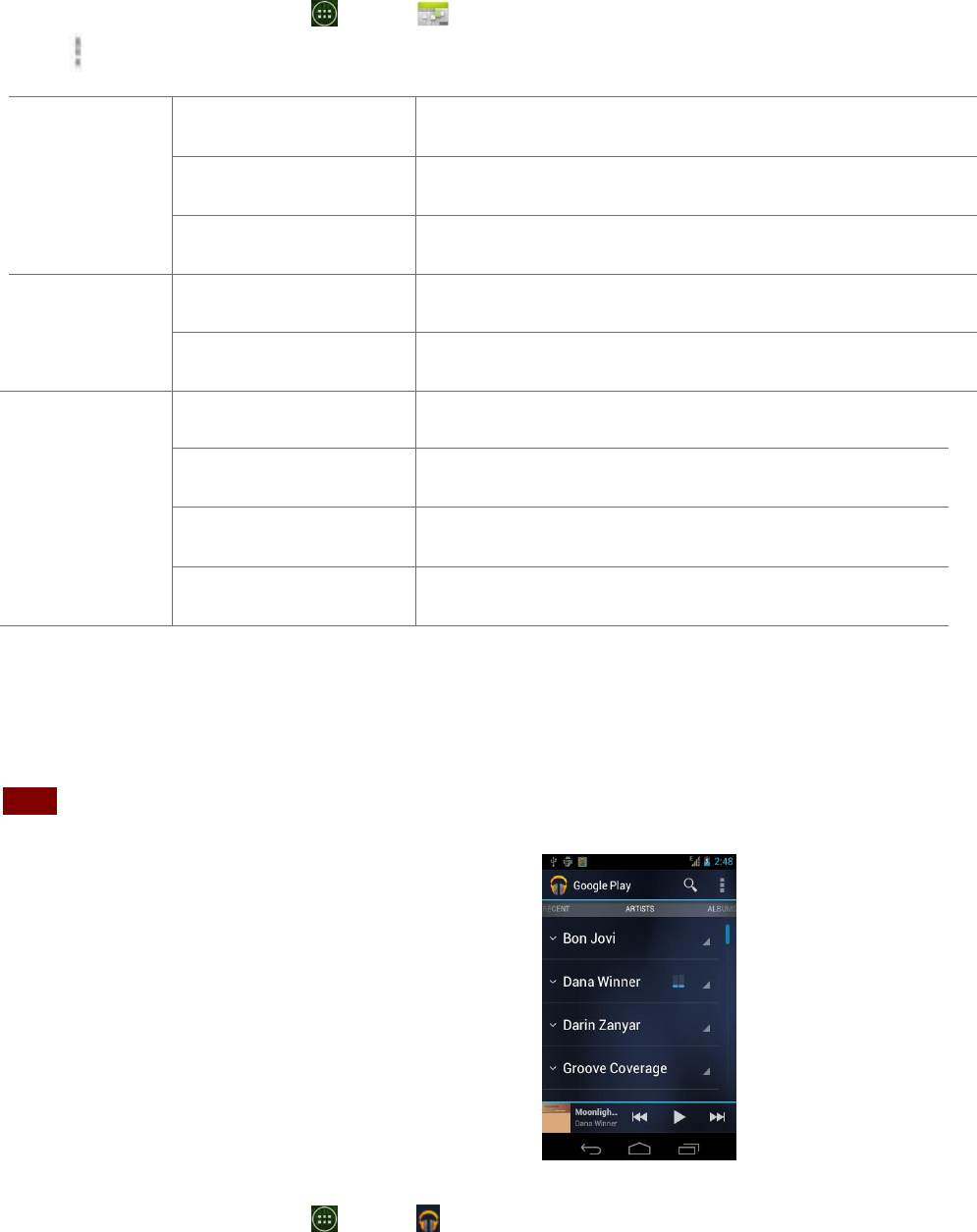
53
4. Tap OK.
Changing Calendar settings
1. From the Home screen, tap Apps >Calendar.
2. Tap Option >Settings.
Calendar view
setting
Hide declined events
Check if you don’t want to see events to which you’ve
declined invitations.
Use home time zone
Displays calendars and event times in your home time
zone when traveling.
Home time zone
If Use home time zone is checked, you can set home time
zone.
Week number
setting
Display week number
Check if you want to see week number in Calendar.
First week of year
If Display week number is checked, you can set first week
of year.
Reminder
settings
Set alerts & notifications
Configure event reminders.
Select ringtone
Select which ringtone will sound when you receive an
event reminder.
Vibrate
Configure the phone to vibrate whenever you receive
an event reminder.
Default reminder time
Select the default reminder time used when creating
new calendar events.
Play Music
Play music and audio files with Music application.
NOTE You need to copy music files to your microSD card to use the Music application.
Viewing your music library
1. From the Home screen, tap Apps >Play Music
2. You can select library to open at the bottom of the screen.
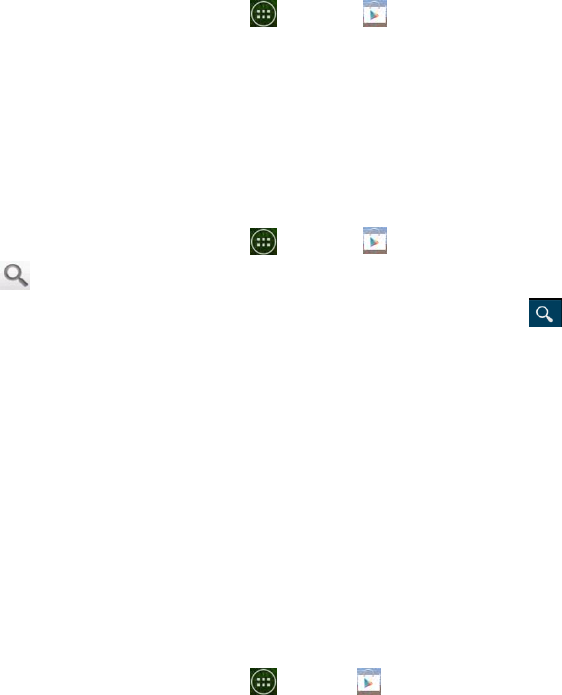
54
• You can view the lists of music in the microSD card.
• The lists are automatically organized according information contained in the music files. To
view each list of music, you can tap the corresponding category; Artists, Albums,
Songs ,Playlists or Genres.
Google Play Store
Google Play Store provides direct access to applications and games to download and install on your
phone. To access Google Play Store, you must first sign into your Google account using a Wi-Fi or
data connection. When you open Google Play Store for the first time, you must read and accept the
terms of service to continue.
Finding applications
Browsing applications
You can browse and sort applications by category.
1. From the Home screen, tap Apps > Play Store.
2. Tap GAMES, BOOKS & REFERENCE, BUSINESS or COMICS, etc. at the left of the Market
screen.
• Scroll to view subcategories and tap one to explore.
3. Tap the subcategory you want.
Searching for applications
1. From the Home screen, tap Apps > Play Store.
2. Tap at the top right of the screen to search apps.
3. Enter the name or type of app you’re looking for >tap to search.
Viewing details about an application
1. While browsing Google Play Store, or in a list of search results, tap an application to view more
details.
Application details screens include a description, ratings, and specific information about the
application. The Comments tab includes comments from people who have used the application.
You can download and install an application from this screen.
Installing applications
Installing an application
1. From the Home screen, tap Apps > Play Store
2. Find the application you want to purchase and view the application details.
3. Tap Download to download and install the application.
For paid applications, the download button is labeled with the application’s price. Tap the price
to buy the application. The subsequent screen notifies you whether the app will require access
to your personal information or access to certain functions or settings of your phone.

55
4. Tap Accept & download to begin downloading and installing the app. If you selected a paid
app, you will be redirected to the Google Checkout screen to pay for the app before it’s
downloaded to your phone.
NOTE Be cautious when downloading apps that have access to phone functionality or a significant amount of
personal data. You’re responsible for the results of using downloaded apps on your phone.
Creating a Google Checkout account
You must have a Google Checkout account to purchase items from Google Play Store. You can
set up a Checkout account with your first purchase from Google Play Store.
• In a web browser, go to http://checkout.google.com to create a Google Checkout account.
• From the phone, you will be prompted to enter your billing and credit card information when
you buy your first application from Google Play Store.
NOTE Once you’ve purchased something from Google Play Store, the phone remembers your password, so
you don’t need to enter it the next time. Be sure to secure your phone with a password to prevent
unauthorized purchases.
Managing your downloads
Viewing downloaded applications
1. From the Home screen, tap Apps > Play Store
2. Tap Option > My Apps.
In the list of the free and paid applications that opens, you can tap an application to rate it, uninstall
it, request a refund, and more.
Updating an application
You can update downloaded applications.
1. From the Home screen, tap Apps > Play Store.
2. Tap Option > My Apps > tap the application to update.
3. Tap Update >Accept & download.
4. Tap the explanation that best matches why you’re installing > tap Open or press Back.
The application is installed. You can uninstall the application again at any time. If you paid to
buy the application, you will not be charged again.
Uninstalling an application
You can uninstall applications from Google Play Store. You can also uninstall downloaded
applications from the Settings.
1. From the Home screen, tap Apps > Settings> Apps.
2. Tap Manage apps >DOWNLOADED > tap the application to uninstall.
3. Tap Uninstall >OK.
4. Tap the explanation that best matches why you’re uninstalling > tap OK.
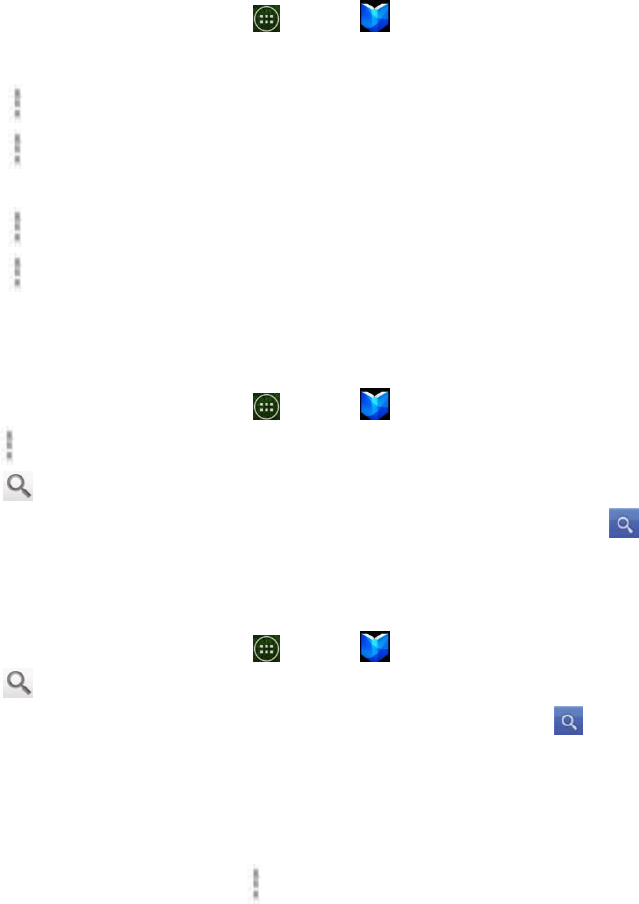
56
The application is uninstalled. You can install the application again at any time. If you paid to buy
the application, you will not be charged again.
Play Books
You can search books you want and enjoy reading books on your phone with Books application. If
you aren’t signed in to your Google account, you must first sign into your Google account using a
Wi-Fi or data connection to access Books.
Opening Books
1. From the Home screen, tap Apps >Play Books.
2. Tap the book you want to read.
• Tap Option >Sort order to sort the books by Date, Title or Author.
• Tap Option >Manage library to remove a book from the My eBooks shelf or manage your
downloaded books.
• Tap Option >Refresh to refresh the current page.
• Tap Option >Accounts to select the desired account or add account.
Finding books
Browsing Google Play Store
1. From the Home screen, tap Apps >Play Books.
2. Tap Option >tap shop to open Google Play Store.
3. Tap at the top right of the screen.
4. Enter the title, author or keyword of the book you want >tap .
5. Scroll through the search results and tap a book to view details about the book.
Searching for books
1. From the Home screen, tap Apps >Play Books.
2. Tap at the top right of the screen.
3. Enter the title or author of book you’re looking for >tap .
4. Scroll through the search results from My eBooks or Google eBooks.
Reading a book
Viewing contents of the book
1. While reading a book, Tap Option >Contents.
2. Scroll through the contents of the book and tap the chapter you want to read.
• Tap the screen to see the title and author of the books on the top of the screen and the
controls. Drag the slider to go directly to a specific chapter of a book.

57
Changing reading settings
1. While reading a book, Tap Option >Settings.
2. Set Text size, Line space, Typeface, Justification, Themes or Brightness.
Going to original pages
1. While reading a book, Tap Option >Original pages.
2. You can read the original pages of the book.
• Tap Option >Flowing text to return to the text mode.
Searching in the book
1. While reading a book, tap .
2. You can search words in the book.
Sharing a book
1. While reading a book, tap Option >Share.
2. Select Bluetooth, Email, Gmail.
Using other functions
1. While reading a book, tap Menu.
2. Tap My library or Help.
• My library: Scroll through the books you downloaded and tap a book to read it.
• Help: Tap one of the items shown below:
Quick tips
You can see quick tips for using Google Books on Android.
Help center
You can learn how to make the most of Google Books on Android.
Contact us
You can get help with issues reading Google Books on your Android device.
Report a
problem
You can report a problem about typo or other error in a book.
Books settings
Customize your Books settings to optimize your reading experience.
1. From the Home screen, tap Apps >Play Books.
2. Tap Option >Settings.
Storage location Setting the location to store your books. You can select microSD card or
internal storage.
About
Show the version of Books application on your phone.
Terms of Service
Read the Mobile Terms of Service.
Privacy Policy
Read the Mobile Privacy Policy.
Open source
licenses
Check out license details for open source software and fonts.

58
Web
Email
The Email application is used to read and send email from services other than Gmail. The Email
application includes a wizard enabling easy setup for several popular email service providers.
Email Account Setup
Initial setup
1. From the Home screen, tap Apps >Email.
2. Enter the Email address and Password for your email account >Next.
If you're adding a second or subsequent email address, you can also check the option to use the
new account to send all outgoing messages.
3. Touch Next. Or if you need to enter email account settings the wizard can't configure for
you, touch “ Manual setup”.
If you touch Next email attempts to communicate with your email service provider to validate
your account for sending and receiving mail, using just your email address and password.
Depending on the service provider, you may be asked what kind of email account you have. If
you're not sure, check the settings in the application you use to send and receive email on your
computer, or ask your email service provider
If the wizard determines that your service provider requires other information, or if you
touched Manual setup, you're prompted to enter your email account details. Refer to the
settings used by your computer-based email application or your email service provider's
support resources.
4. Enter a name for the account, confirm how you want your name to appear in outgoing mail,
and touch Done.
Email starts downloading your email messages and you can start using it to send and receive
messages using the new account.
Adding an additional email account
You can add one or more email accounts to your phone.
1. From the Home screen, tap Apps >Email.
2. Tap Option >Accounts.
3. Tap Option >Add account.

59
4. Repeat the steps to add an account as described in Initial setup above.
Deleting an email account
1. From the Home screen, tap Apps > Email.
2. Tap Option >Accounts.
3. Tap and hold the account >Remove account.
Refreshing an email account
1. From the Home screen, tap Apps > Email.
2. Tap Option >Refresh.
• If you have several email accounts, you can refresh them all at the same time.
From any message inbox, tap Option >Accounts >Combined Inbox >Refresh.
Reading an email
You can read messages in your Combined Inbox or individual account folders.
1. From the Home screen, tap Apps > Email.
• Tap Option to see more options.
2. Tap an email you want to read.
• Tap Option to see more options.
Replying to a message
1. While reading an email, select Reply or Reply all.
• A Compose Message window opens with recipient addresses, and subject line pre-populated.
A copy of the original message is quoted below the message body text box.
2. Compose your response and tap Send.
Forwarding a message
1. While reading an email, tap Option >Forward.
2. Address the email, enter a subject, and type your message in the appropriate text fields.
3. Tap Send.
Deleting a message
1. While reading an email, tap Delete.
Sending a new email
1. From the Home screen, tap Apps > Email.
2. Tap to create new email.

60
3. Enter a name or email address in the To field. If you are sending the mail to several
recipients, separate the email addresses with a comma “,”.
• As you enter text, matching addresses are suggested from your Contacts list.
• Tap Option >Add Cc/Bcc to add additional recipient field types.
4. Enter a Subject and type your message.
• To attach an image file, tap > select the picture you want to attach.
NOTE The attachable file size is limited to 5 MB.
5. Tap Send.
• To save an unsent email message on your phone, tap Save as draft.
• To cancel an email message, tap Discard.
Starring/un-starring an Email
You can star an important message to find it easily later. Once you start a message, a Starred folder
is added to the Accounts screen.
1. From any email list or while reading a message:
• Tap to star the message.
• Tap to un-star.
Working with Email Messages
Viewing starred messages
1. From the Home screen, tap Apps > Email.
2. Tap Option >Accounts >Starred.
Resuming a draft email message
1. From the Home screen, tap Apps > Email.
2. Tap Option >Folders or Accounts >Drafts.
3. Tap an email you want to resume > finish editing the message.
4. Tap Send.
Viewing individual account folders
1. From the Home screen, tap Apps > Email.
2. Tap Option >Accounts > select to view individual account folders. Select any folder to open,
view, or edit contents.
Email account settings

61
1. From the Home screen, tap Apps > Email.
2. Tap Option >Account settings.
General
settings
Account name
The name of the account as it appears in the Accounts and Folders
screens.
Your name
Your name shown in outgoing messages.
Use Signature
Check it to use signature.
Signature
Enter a signature to append to messages sent from this account.
Email check
frequency
Set how often the phone will for new email sent to this account.
Download
Options
You can select Head Only, 1k, 5k, 25k, 50k, 100k, 1M or All.
Default
account
Check it to set this account as the ‘default’ account for outgoing
messages.
Notification
settings
Email
notifications
Check it to receive notifications when new messages are received
in this account.
Select ringtone
Select a notification ringtone.
Vibrate
Select to configure vibration notifications when new emails arrive
in this account.
Server
settings
Incoming
settings
Configure Incoming server settings for this account.
Outgoing
settings
Configure Outgoing server settings for this account.
3. Press Back to save changes.
NOTE Web services (Email, Browser, YouTube, etc.) are a data-intensive feature.
Browser
Search for information or browse web pages using the Browser. To access the internet, you must
have an active data or Wi-Fi connection.
Opening Browser
1. From the Home screen, tap Apps >Browser.
• When you open the Browser, the default homepage is displayed. If you have used the
Browser recently, your most recently viewed webpage is displayed.
• The Browser also opens when you select a web link in other applications like email or text
messaging.
Accessing a webpage or searching the web

62
1. From the Home screen, tap Apps >Browser.
2. Tap the URL field on top of the screen.
3. Enter the URL of a webpage or search term and tap “Go”.
• As you type, suggestions of web pages and key words will appear on the screen. Tap a
suggestion to go directly to that webpage or view search results.
Using Browser options
Stopping page loading
1. While webpage is loading, tap Option >Stop. Or tap on the left of the URL field.
Refreshing the current page
1. Tap Option >Refresh.
Finding the text on the current page
1. While viewing any web pages, tap Option >Find on page.
2. Enter the search term.
• As you type, matching characters will be highlighted. Tap ∧or ∨to scroll to the previous
or next matching term.
Sharing a webpage
1. While viewing any web pages, tap Option >Share page.
2. Tap an application to send the URL. The application opens with the URL you’ve entered.
Downloading files
You can download images, files, and applications from web pages. All downloaded files are saved to
the microSD card.
1. Tap and hold an image, a link or a file you want to download.
2. Tap the desired action (Save image, View image, or Set as wallpaper).
Navigating between webpages
• Press Back to return to the previous web pages.
Or tap Option >Forward if you pressed Back by accident.
Switching between Browser windows
1. From any web pages, tap Option >Bookmarks >tap HISTORY .
2. Tap the window to view it full screen. You can also tap to close a window.
NOTE You can have up to 8 browser windows open at one time.

63
Using bookmarks
Browser bookmarks are stored shortcuts which allow you to quickly access webpages without
having to type in its full address.
Bookmarking a webpage
1. While viewing webpages, tap Option >Save to bookmarks.
2. Edit the name or location if needed >tap OK.
Opening a bookmark
1. When viewing any webpages, tap Option >Bookmarks.
2. Tap a bookmark to open it.
• If you prefer to open the webpages in a new window, tap and hold the bookmark and tap
Open in new tab.
Editing a bookmark
1. From any webpages, tap Option >Bookmarks.
2. Tap and hold the bookmark to edit >Edit bookmark.
3. Edit the name and/or location >tap OK.
Deleting a bookmark
1. From any webpages, tap Option >Bookmarks.
2. Tap and hold the bookmark to delete >Delete bookmark >OK.
Browser settings
Customize your browser settings to optimize your browsing experience.
1. From the Home screen, tap Apps >Browser.
2. Tap Option >Settings.
General settings
Set home page
Select the home page
Form auto-fill
Fill out web forms with a single touch
Auto-fill text
Set up text to auto-fill in web forms
Privacy &
Security
Clear cache
Tap it you can clear locally cached content and databases
Clear history
You can clear the browser navigation history
Show security
warning
If you tap it ,it will show warning if there’s a problem
with a site’s security
Accept cookies
Allow sites to save and read cookie data
Clear all cookie data
Delete all cookie data

64
Remember form
data
Remember what you enter in form fields
Clear form data
Delete all the information the browser remembered
Enable location
Allow sites to request access to your location
Clear location
access
Delete location access for all websites
Remember
passwords
Save your passwords for some webpages that require
you to sign in.
Clear passwords
Delete all saved passwords
Accessibility
settings
Force enable zoom
Override a website’s request to control zoom behavior
TEXT SIZE
Text scaling ,Zoom on double-tap and Minimum font size
INVERTED
SCREEN
RENDERING
Making the black becomes white and vice versa
Advance settings
Set search engine
You can choose Google, Yahoo, Bing Etc to browse the
web
Open in
background
Tap to open new tabs behind the current tab
Enable JavaScript
Allow JavaScript to run on web pages.
Website settings
Set for individual websites.
Page content
Set for the page content
Reset to default
Restore default settings
Bandwidth
management
Search result
preloading
Allow browser to pre load high confidence search results
in the background
Load images
Display images on web pages
Labs settings
Fullscreen
Use full screen mode to hide the status bar
Slide Tab
Transitions
Swipe from the edge to reveal the next/previous tab in the
list
YouTube
YouTube is Google’s online video streaming service for viewing, discovering, and sharing videos.
Opening and signing into YouTube
Signing into YouTube
You can discover and watch YouTube videos without a YouTube account, but if you want to take
advantage of many YouTube features, you must sign into your YouTube account.

65
1. From the Home screen, tap Apps >YouTube.
2. Tap Option >My Channel.
The first time you use a YouTube feature that requires an account, you’re prompted to sign in.
Create a new account or enter your YouTube sign in information if you already have an
account. For more information about YouTube accounts, visit YouTube on the web.
Finding videos
Browsing videos by category
1. From the Home screen, tap Apps >YouTube.
2. Tap Option >Browse.
3. Tap a category in the scrolling list.
• Tap the current time filter setting at the top of the category screen to change the time
period and reduce the number of videos listed.
• Tap Most viewed, Top rated, Most discussed or Top favorite.
Searching for videos
1. From the Home screen, tap Apps >YouTube.
2. Tap Search.
3. Enter the search criteria >tap to search.
4. Scroll through the search results and tap a video to watch it.
Watching videos
1. From the Home screen, tap Apps >YouTube.
2. Tap a video to begin playback.
• Tap the video to pause or resume playback.
• Tap Info, Related videos or Comments to learn more about the video.
• Rotate your phone to watch the video in full-screen view. You can also double-tap the
video to toggle full-screen view on and off.
Add to
Watch later
Bookmark the video to watch it later.
Favorites
Add the video to your Favorites.
New
playlist
Add your new playlist.
Share
Share the video via Bluetooth, Email, Gmail
Uploading videos
To shoot and upload a new video
1. From the Home screen, tap Apps >YouTube.

66
2. Tap . The Camera will open in video mode.
3. Tap to start recording > tap to stop recording.
4. Enter a title for the video and more details > tap Upload.
To upload an existing video
1. From the Home screen, tap Apps > YouTube.
2. Tap Option>Upload. The Gallery will open.
3. Tap the video you want to upload.
4. Enter the title for the video and more details >tap Upload.
Sharing videos
1. From the Home screen, tap Apps > YouTube.
2. Tap a video to play.
3. Tap Share.
4. Tap the application you want to use to share the video.
YouTube settings
You can change the following settings for YouTube on your phone.
1. From the Home screen, tap Apps > YouTube.
2. Tap Option>Settings.
General
settings
High quality on mobile
Check if you prefer to watch videos in high resolution by
default when connected to mobile networks. Watch videos
in standard mode to reduce startup time and data use. This
setting has no effect if you are connected to a Wi-Fi
network, where videos are always shown in higher
resolution.
Caption font size
Set the preferred text size when viewing video captions.
Uploads
Specify network preferences for uploads.
Search
settings
Clear search history
Remove previous YouTube video search results.
SafeSearch filtering
Select if you want Google SafeSearch filtering to block
some results when you search for videos. Settings are:
Block no search results (Don’t filter), only explicit or
offensive videos (Moderate), or both explicit and offensive
text and videos (Strict).
Preloading
Preload subscriptions
Enable preload to fetch videos in advance while on Wi-Fi
and charging, so you can enjoy watching them later on slow
networks
Preload watch later
About
Help
Open the YouTube Help Center in your phone’s Browser.
Feedback
Open a YouTube feedback form in your phone’s Browser.

67
Google Mobile Terms
of Service
Display the Google Mobile Terms of Service.
YouTube Terms of
Service
Display the YouTube Terms of Service.
Google Mobile Privacy
Policy
Display the Google Mobile Privacy Policy.
YouTube Privacy
Policy
Display the YouTube Privacy Policy.
Application version
The YouTube application version number installed on your
phone.
Wi-Fi
Turning Wi-Fi on and connecting to a wireless network
1. From the Home screen, tap Apps >Settings.
2. Tap Wireless & networks >Wi-Fi.
3. Select the Wi-Fi check box to turn Wi-Fi on.
4. The network names and security settings of detected Wi-Fi networks are displayed.
5. Tap a Wi-Fi network to connect.
• If you selected a network that is secured, enter the security key and then tap Connect.
Depending on the network type and security settings, you may also need to enter more
information or choose a security certificate.
Connecting to a Wi-Fi network with EAP-TLS security
You may need to install a network certificate to your phone before you can connect to a Wi-Fi
network with EAP-TLS authentication protocol.
1. Save the certificate file to the root folder of the microSD card.
2. From the Home screen, tap Apps >Settings.
3. Tap security >Install from SD card.
4. Select the network certificate needed to connect to the EAP-TLS network.
5. After the certificate is installed, follow the steps in the previous section to connect to the Wi-Fi
network.
Checking wireless network status
1. From the Home screen, tap Apps >Settings.
2. Tap Wi-Fi.
3. Tap the wireless network that the phone is currently connected to.
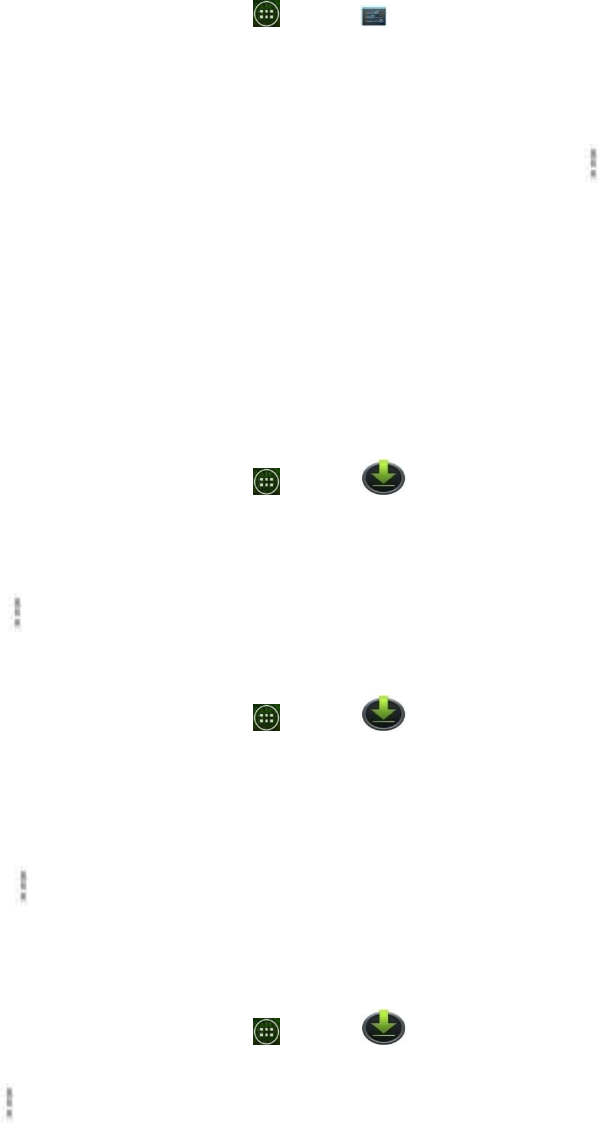
68
A message box is then displayed showing the Wi-Fi network name, status, speed, signal strength,
and more.
Connecting to another Wi-Fi network
1. From the Home screen, tap Apps >Settings.
2. Tap Wi-Fi.
3. Detected Wi-Fi networks are displayed in the Wi-Fi networks section. To manually scan for
available Wi-Fi networks, on the Wi-Fi settings screen, tap Scan.
• To set advanced settings, on the Wi-Fi settings screen, tap Option>Advanced.
4. Tap another Wi-Fi network to connect to it.
Downloads
Images, files and other items you download in Browser, Gmail, Email is stored on your phone.
You can view, manage or delete what you have downloaded.
Opening Downloads
1. From the Home screen, tap Apps >Downloads.
2. Tap an item you want to view it.
• Check the checkbox of the item you want to delete and then tap Delete.
• Tap Option to select Sort by size or Sort by time.
Viewing a file
1. From the Home screen, tap Apps >Downloads.
2. Tap the file you want to open.
• Turn your phone left or right to view the file in upright (portrait) or sideways (landscape)
orientation.
3. Tap the screen to see the controls.
• Tap Option to view more options.
Working with files
1. From the Home screen, tap Apps >Downloads.
2. Tap the file you want to manage.
3. Tap Option to Share, Delete.
• Tap Share to share the selected file.
• Tap Delete to delete the selected file.

69
Bluetooth
Using Bluetooth
Bluetooth is a short-range wireless communications technology that devices can use to exchange
information over a distance of about 30 feet. The most common Bluetooth devices are headphones,
hands-free car kits, and portable devices, including laptops and cell phones.
Turning Bluetooth on or off
1. From the Home screen, tap Apps >Settings>Bluetooth.
2. Check or uncheck Bluetooth to turn it on or off.
Changing the phone’s Bluetooth name
The phone name identifies your phone to other devices.
1. From the Home screen, tap Apps >Settings.
2. Tap Bluetooth.
3. If Bluetooth isn’t turned on, check Bluetooth to turn it on.
4. Tap Option> Rename phone > Enter the name for your phone in the dialog box >OK.
Pairing your phone with a Bluetooth device
1. From the Home screen, tap Apps >Settings.
2. If Bluetooth isn’t turned on, check Bluetooth to turn it on.
3. Tap Bluetooth >Search for devices. A list of nearby Bluetooth devices is displayed.
4. Tap the ID of the other device to pair them.
Connecting to a Bluetooth device
Once paired, your phone will automatically connect whenever it detects a paired Bluetooth
device. You can also manually connect Bluetooth devices as follows:
1. From the Home screen, tap Apps >Settings.
2. If Bluetooth isn’t turned on, check Bluetooth to turn it on.
3. Tap Bluetooth >Search for devices.
4. When the phone and the device are connected, the device is displayed as connected in the list.
Disconnecting or Un-pairing from a Bluetooth
Device
Disconnecting a Bluetooth device

70
1. From the Home screen, tap Apps >Settings.
2. Tap Bluetooth.
3. In the Bluetooth devices section, tap and hold the device name to disconnect.
4. Tap Disconnect.
Un-pairing from a Bluetooth device
You can make your phone forget its pairing connection with another Bluetooth device.
1. From the Home screen, tap Apps >Settings.
2. Tap Bluetooth .
3. In the Bluetooth devices section, tap of the device name to un-pair.
4. Tap Un-pair.
Connecting to a Bluetooth Headset
1. From the Home screen, tap Apps >Settings.
2. Tap Bluetooth.
3. If Bluetooth isn’t turned on, check Bluetooth to turn it on.
4. Tap Search for devices. Your phone will start to scan for Bluetooth devices within range.
5. When you see the name of your headset displayed in the Bluetooth devices section, tap the
name. Your phone then automatically tries to pair with the Bluetooth device.
6. If automatic pairing fails, enter the passcode supplied with your headset.
Reconnecting a headset
1. Put the Bluetooth device in pairing mode.
2. From the Home screen, tap Apps >Settings.
3. Tap Bluetooth.
4. If Bluetooth isn’t turned on, check Bluetooth to turn it on.
5. Tap the device’s name in the Bluetooth devices section.
6. If prompted to enter a passcode, try 0000 or 1234, or consult the headset documentation to find
the passcode.
Sending and Receiving Information Using Bluetooth
You can use Bluetooth to transfer information between your phone and another Bluetooth-enabled
device such as a phone or laptop computer. You can send the following types of information,
depending on the device you are sending to:
• Images and videos
• Contacts

71
• Audio files
To send files, your phone must have a microSD card installed.
NOTE The first time you transfer information between your phone and another device, you need to enter or
confirm a security passcode. Your phone and the other device are then paired, and you will not need to
exchange passcodes to transfer information in the future.
1. On your phone, open the application that contains the item you want to send.
2. Follow the steps for the type of the application, select Send File or Send in the menu. Then
select Bluetooth.
3. If you are prompted to turn on Bluetooth, tap Turn on.
4. Tap the name of the receiving device.
5. On the receiving device, accept the file.
Receiving information from another device
Your device is capable of receiving a wide variety of file types with Bluetooth, including photos,
music tracks, and documents such as PDFs.
To receive files from another device, your phone must have a microSD card installed.
1. From the Home screen, tap Apps >Settings.
2. Tap Bluetooth.
3. If Bluetooth isn’t turned on, check Bluetooth to turn it on.
4. Tap the name of the bluetooth to make the device available.
5. On the sending device, send one or more files to your phone.
6. If a Bluetooth authorization request is displayed on your phone, enter the same passcode on
both your phone and the other device, or confirm the auto-generated passcode.
7. When your phone receives a file transfer request notification, slide down the notifications panel,
and then tap Accept.
8. When the transfer is complete, a notification is displayed. To open the file immediately, slide
down the notifications panel, and tap the notification.
Entertainment
Camera/Camcorder
You can take pictures and shoot videos with Camera/Camcorder. Photos and videos captured with
the camera will be stored on the phone’s microSD card. A microSD card must be installed to use the
Camera/Camcorder.
Opening Camera
• From the Home screen, tap Apps >Camera.

72
• Or, when in Camcorder mode, tap to choose change to camera.
Camera settings
When in Camera mode, Camera settings are displayed on screen. Before taking the photo, you can
adjust your camera settings or leave the controls in automatic mode.
1. From the Home screen, tap Apps >Camera.
2. Tap >tap Option. The settings open over the screen.
Tap the setting you want to change.
General
settings
Exposure
+2, +1, 0, -1, -2
Focusmode
Auto, Off
Picture size
3M Pixels, 2M Pixels, 1M Pixels, VGA, QVGA
Picture
quality
Super fine, Fine, Normal
Color effect
None, Mono, Sepia, Negative
Camera
settings
Restore defaults
Store location
Off / On
Activate to use your phone’s location-based services. Take pictures
wherever you are and tag them with the location.
White
balance
Auto, Incandescent, Daylight, Fluorescent, Cloudy.
Zoom
﹣/﹢
Tap the amount of zoom you want.
3. Tap < to close the settings menus.
Taking a picture
1. From the Home screen, tap Apps >Camera.
2. Frame your subject on screen.
• Tap . The camera brings the image into focus. When the image is in focus, the camera takes
a picture.
The picture you just took is briefly previewed full-screen, and then is displayed as a
thumbnail at the top right. Tap the thumbnail to view, share, or work with your pictures in
Gallery.
Opening Camcorder
•When you’re in Camera mode, tap to choose change to camcorder. Or tap Apps>
Camcorder.
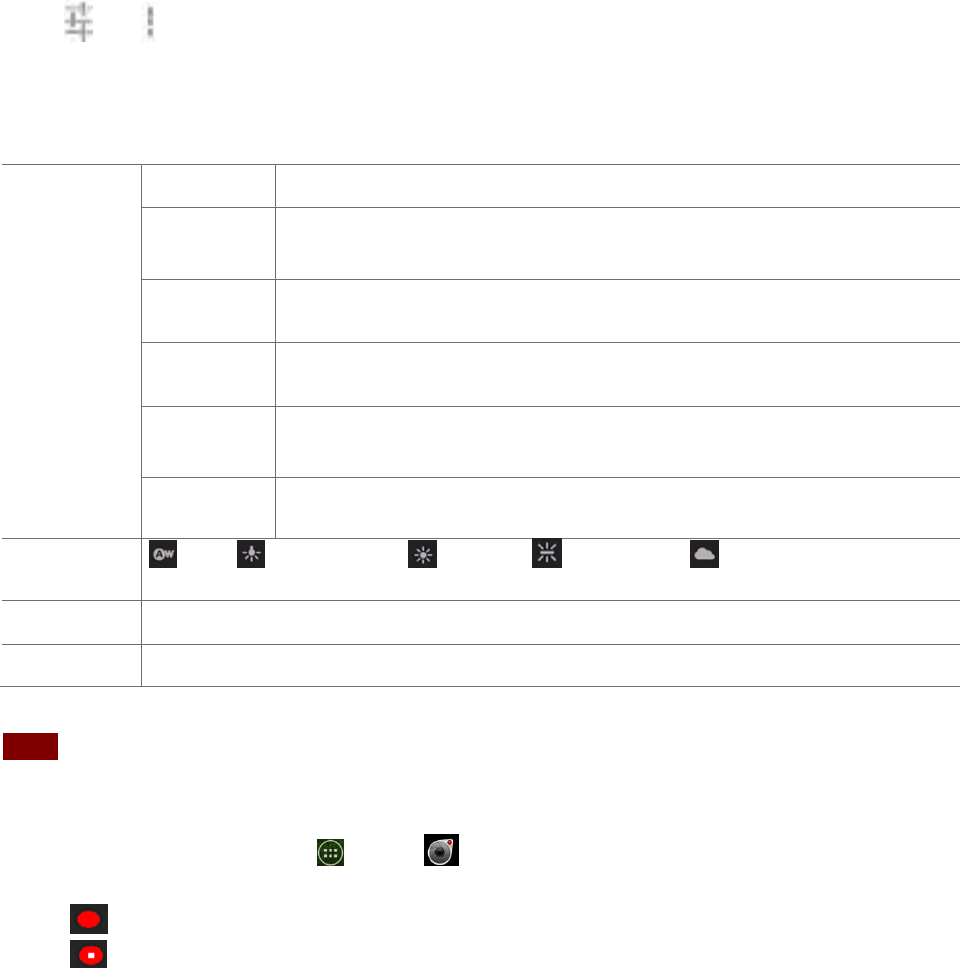
73
Camcorder settings
When in Camcorder mode, Camcorder settings are displayed on screen. Before recording, you
can adjust your camcorder settings or leave them in automatic mode.
Tap >tap Option. The settings open over the screen.
• Tap < to close the settings menus
Tap the setting you want to change.
General
settings
Color effect
None, Mono, Sepia, Negative
Video
quality
WVGA, VGA, CIF, QVGA, QCIF
Video
Encoder
MPEG4, H263, H264
Audio
Encoder
AMRNB, AAC
Video
duration
30 seconds (MMS), 10 minutes, 30 minutes
Camera
settings
Restore defaults
White
balance
Auto, Incandescent, Daylight, Fluorescent, Cloudy.
Flash mode
On, Off
Video quality
High (30m), Low (30m), MMS (Low, 15s), YouTube (High, 10m), Custom
NOTE Depending on the selected video quality, not all video quality and video encoder options may be available.
Recording videos
1. From the Home screen, tap Apps >Camcorder.
2. Frame the scene where you want to start recording.
3. Tap to start recording.
4. Tap to stop recording.
An image from your most recent video is displayed as a thumbnail at the top right. Tap the
thumbnail to view, share, or work with your videos in Gallery.
Gallery
Using Gallery to view your pictures and videos. You can edit and add effects to your photos. You
can also easily add a photo as your contact icon, location icon, or wallpaper.

74
Opening Gallery and viewing album lists
Opening Gallery
• From the Home screen, tap Apps >Gallery.
• Or when you’re in Camera/Camcorder mode, tap the thumbnail image at the top right. Your
album list is displayed. Albums are groups of images and videos in folders.
Managing albums
1. From the Home screen, tap Apps >Gallery.
2. Check the albums you want.
3. Tap Option.
• Tap Share > tap the application to use to share the selected albums. You can share the
entire contents of one or more albums.
• Tap Delete >tap Confirm Delete to delete selected albums and all contents from your
microSD card.
• Tap Slideshow > you can play Slideshow.
Opening an album and viewing its contents
Viewing contents of an album
After you’ve selected an album, you can browse through your pictures and videos. Albums open
displaying the pictures and videos they contain in a chronologically ordered grid. The name of the
album is shown at the top of the screen.
1. From the Home screen, tap Apps >Gallery.
2. Swipe left or right across the screen to view additional albums then tap an album to open and
view its contents.
3. When you open an album,
• Swipe left or right across the screen to view more contents. Tap a thumbnail image to view it.
Working with pictures or videos in batches
You can select one or more pictures or videos in an album to work on them in batches.
1. From the Home screen, tap Apps >Gallery.
2. Tap the album you want to open.
3. Check the pictures or videos you want.
• Tap Share > tap the application to use to share the selected items.
• Tap Option >tap Delete >tap Delete to delete selected items from your microSD card.

75
• Tap Option > tap Details to get details about selected items. The controls available depend
on the mix of selected items.
Viewing pictures
Viewing a picture
1. From the Home screen, tap Apps >Gallery.
2. Tap the album you want to open, and then tap a thumbnail image of picture to view it.
• Swipe left or right across the screen to view the previous or next picture in the album.
• Turn your phone left or right to view the picture in upright (portrait) or sideways (landscape)
orientation.
3. Tap the screen to see the controls.
• Tap double-tap the screen to zoom in or out.
• Tap Option >tap Slideshow to watch a slideshow of your pictures and videos in the album.
Tap the screen to stop the slideshow.
• Scroll to up to view more options.
Working with pictures
1. From the Home screen, tap Apps >Gallery.
2. Tap the album you want to open, and then tap a thumbnail image of the picture.
3. Tap Share >tap the application to share the picture. You can share a picture by sending it to
friends or posting it in a Picasa web album.
• Tap Option > tap one of the icons shown below:
Details
Get details about the picture.
Set people as
Contact
people
Use a picture as a contact icon.
Wallpaper
Use a picture as Home screen wallpaper.
Crop
Crop a picture.
Rotate Left / Rotate Right
Rotate a picture.
Delete
Delete the picture
Edit
Edit the picture
Slideshow
Play slideshow
Playing videos
1. From the Home screen, tap Apps >Gallery.
2. Tap the album you want to open, and then tap a thumbnail image of the video to view it.
You can view the video in landscape or portrait mode.

76
Sound Recorder
Opening Sound Recorder
You must have a microSD card installed to use Sound Recorder.
1. From the Home screen, tap Apps >Sound Recorder.
2. Tap to start recording a voice clip.
3. Tap to stop recording.
• To save the voice clip, enter voice record name > tap Done.
• To discard the voice clip, tap Discard.
• Tap to listen to the recording.
Facebook
Before using the Facebook you must connect the WI-FI or data connection on a mobile.
Opening the Facebook
1. From the Home screen, tap Apps> Facebook
•If you have the Facebook account, you can enter the Email and Password, and tap the log in is ok.
•If you haven’t the Facebook account, you must sign up for Facebook on the phone or on computer.
Twitter
Before using the Twitter you must connect the WI-FI or data connection on a mobile.
Opening the Facebook
1. From the Home screen, tap Apps> Twitter
•If you have the Twitter account, you can enter the Email and Password, and tap the sign in is ok.
• If you haven’t the Twitter account, you must sign up for Twitter on the phone or on computer.
Tools
Clock
Opening the Clock
1. From the Home screen, tap Apps >Clock.
• The Clock application opens and displays the date, time and other useful information.
•Tap Set alarm to set alarm.
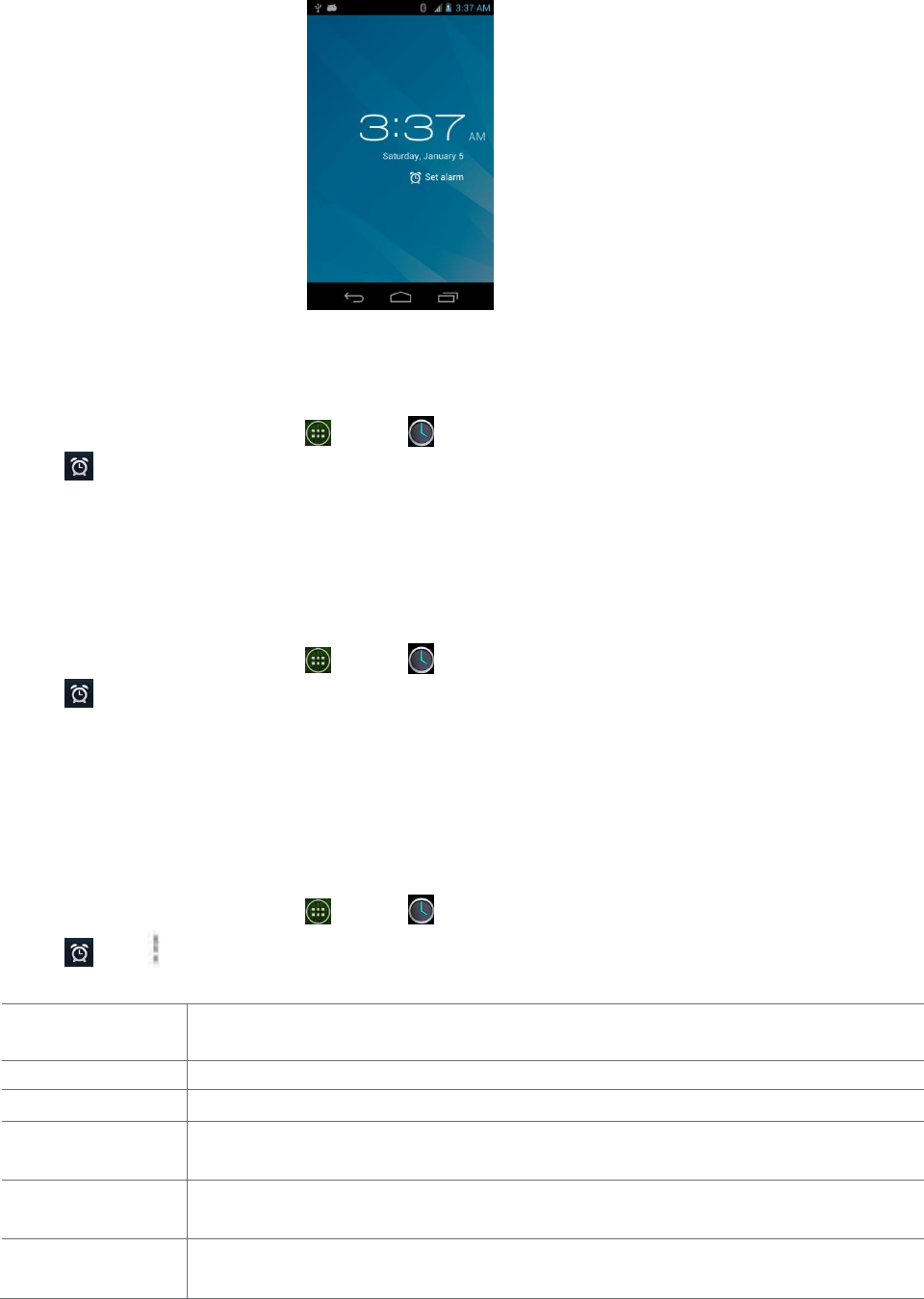
77
Managing Alarms
Adding a new alarm
1. From the Home screen, tap Apps >Clock.
2. Tap Set alarm> Add alarm.
3. To change the alarm time, scroll up and down to type the number. Then toggle AM/PM >Set.
4. Check the checkbox, ‘Turn alarm on’.
5. Edit Turn alarm on, Time, Repeat, Ringtone, Vibrate and Label >Ok.
Editing an alarm
1. From the Home screen, tap Apps >Clock.
2. Tap > Tap an existing alarm.
3. Turn the alarm on or off by checking or un-checking the checkbox, ‘Turn alarm on’. In the
alarm list, set alarms are underlined in green.
4. Edit Time, Repeat, Ringtone, Vibrate and Label >Done. Or tap Delete to remove the alarm
>OK.
Changing alarm settings
1. From the Home screen, tap Apps >Clock
2. Tap > tap Option >Settings.
Alarm in silent
mode
Check to play alarms even when the phone is in silent mode.
Alarm volume
Set the volume of alarms.
Snooze duration
Set how long Clock waits before playing an alarm again.
Auto-silence
Alarm will silence after 10 minutes
Volume button
Set the side button behavior for alarms.
Set default
ringtone
Set ringtone default

78
Stopping an alarm
1. When the alarm sounds, tap Dismiss to stop the alarm.
• Tap Snooze to repeat the alarm after a specified length of time.
Calculator
Using Calculator
1. From the Home screen, tap Apps >Calculator.
2. Enter numbers and arithmetic operators.
• Tap Option >Advanced panel.
• Tap and hold the Calculator’s display to open a text editing menu. You can cut, copy, and
select text for use in Calculator or other Applications.
• Tap Clear history to delete the last number or operator you entered. Tap and hold DELETE to
delete everything in the display.
Settings
Settings on Your Phone
Control and customize phone settings on the Settings screen.
1. From the Home screen, tap Apps >Settings.
Wireless & networks
Wi-Fi/ Wi-Fi
settings
Wi-Fi On / Off.
Set up and manage Wi-Fi networks. For details about working with these
settings, see “Wi-Fi”.
Bluetooth/
Bluetooth
settings
Bluetooth On / Off.
For details about working with these settings, see “Bluetooth”.
Date usage
This setting you can see mobile data and wi-fi data statistics, and you can turn on
or turn off the data.
more
VPN settings
Set up and manage Virtual Private Networks (VPNs).
Cell broadcasts
Select the types of emergency alerts to display.
Tethering
&portable hotspot
Set up Wi-Fi hotspot
Airplane mode
Airplane mode On / Off.
Check to turn off all the phone’s radios that transmit voice or data.
Mobile network
The settings include Data enable, Data roaming, Access Point Names. And
you can choose use only 2G network to save battery, also you can select a
network operator.
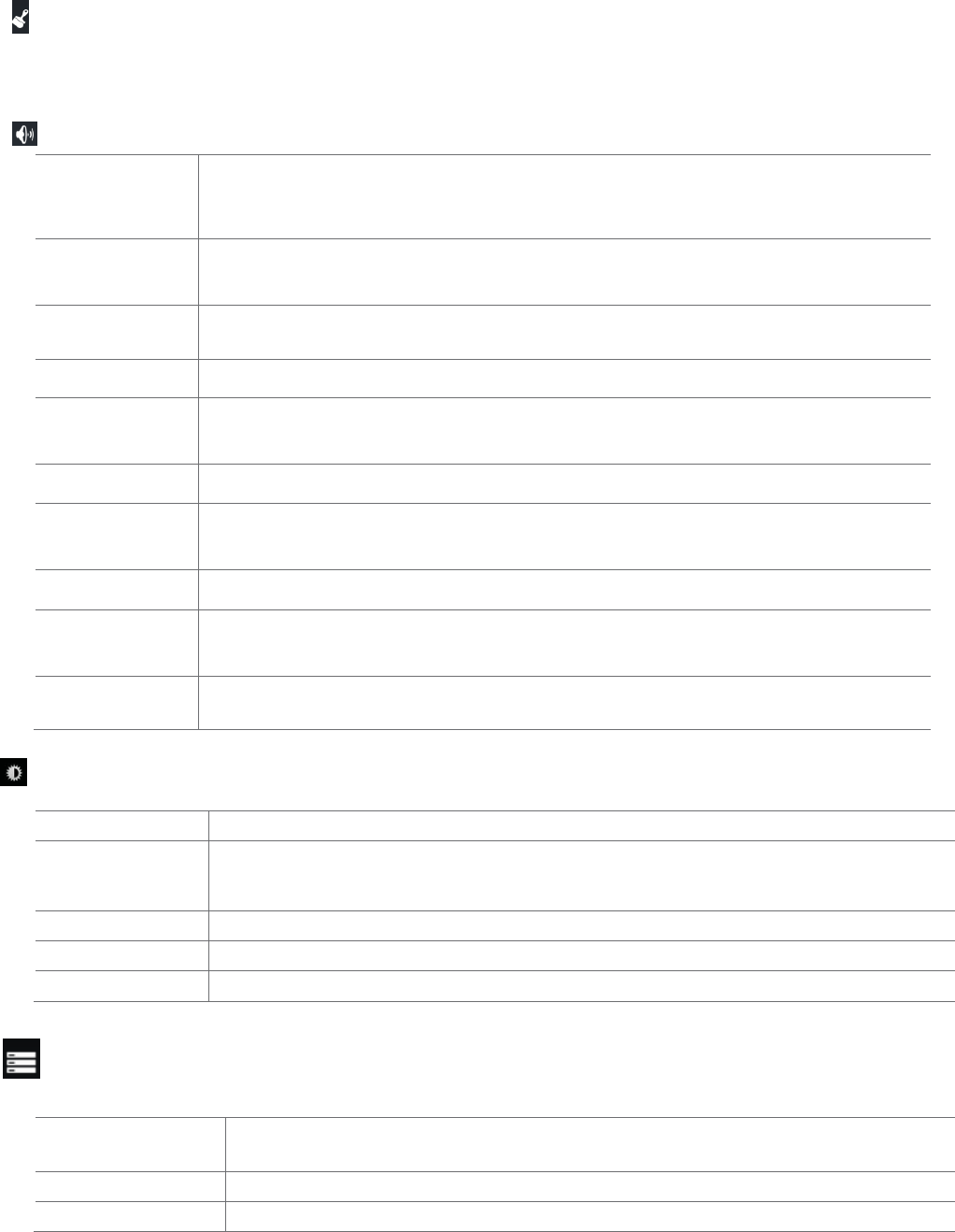
79
Theme setting
You can switch to them Default or Nature (Preload). If you “OK” the new theme will be effective
immediately.
Sound
Silent mode
When set to silent mode, your phone doesn’t play any ring, alert, and effects
sounds.
You must silence media and alarms in their own applications.
Vibrate
Configure when you want the phone to vibrate when you receive a phone call
or notification.
Volume
Set the volume of ringtones that sound when you receive a phone call or
notification, media (music, videos, and so on), and alarms.
Phone ringtone
Select the ringtone to sound when you receive a phone call.
Default
notification
Select the ringtone to sound when you receive a notification.
Vibrate on ring
Vibrate when the ringtone ring out
Dail pad touch
tones
Check to play tones when using dial pad.
Touch sound
Check to play sound when touching the panel.
Screen lock
sounds
Check to play sounds when locking and unlocking the screen.
Vibrate on touch
When touch the panel will vibrate
Display
Brightness
Adjusting the brightness of the screen.
Auto-rotate
screen
Automatically switch the orientation of the screen as you turn the phone
sideways or even upside down.
Wallpaper
You can set wallpaper
Sleep
Adjust the delay before the screen automatically turns off.
Font size
You can set the size of display
Storage
Storage manager, you can see the SD card and the phone space.
Unmount SD card
Unmout the SD card so you can safely remove it
Erase SD card
Erases all data on the SD card, such as music and photos
Mount SD card
Add SD card
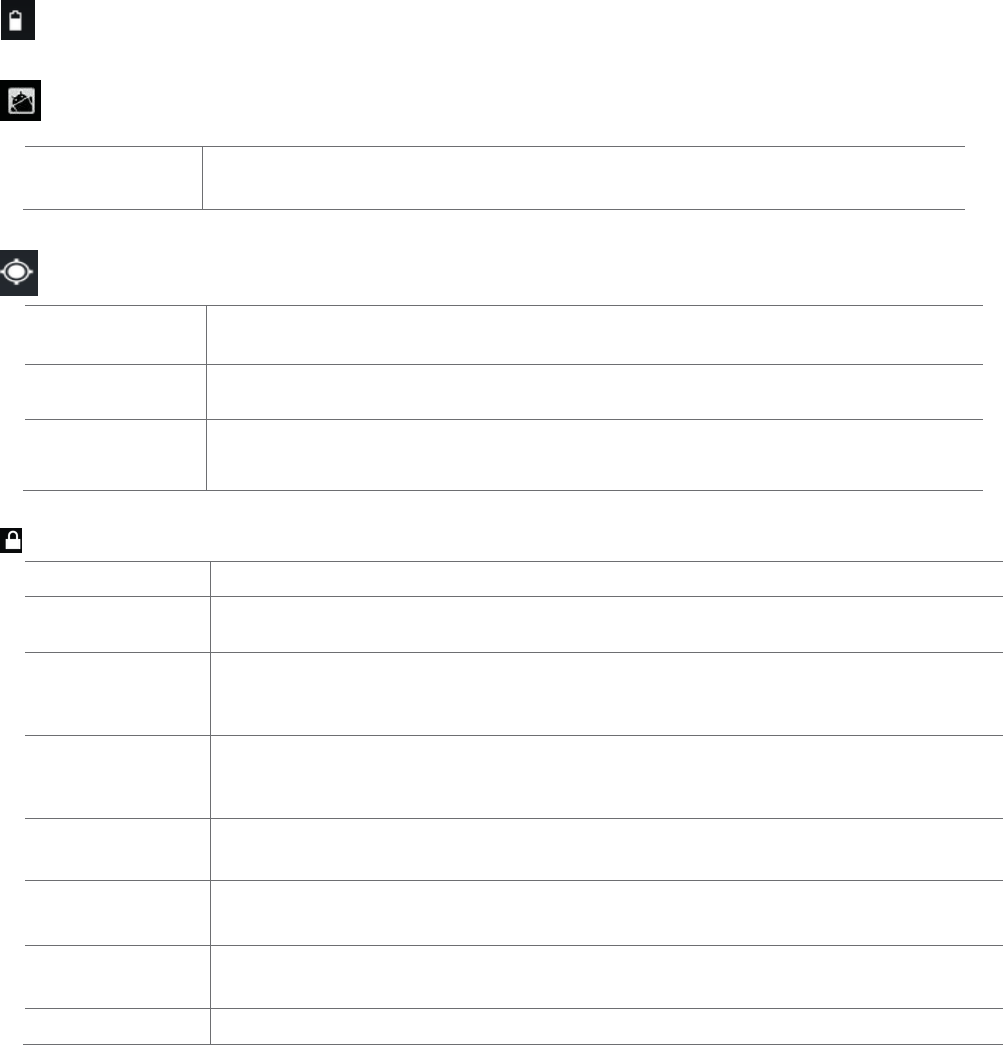
80
Battery
Tap Battery you can see how much the apps using the battery and the all battery.
Apps
Manage
applications
Manage and remove installed applications.
Location access
Access to my
location
Let apps that have asked your permission use your location information.
GPS satellites
Let apps use GPS on your phone to pinpoint your location.
Wi-Fi & mobile
network location
Let apps use Google’s location service to estimate your location faster.
Anonymous location data will be collected and sent to Google.
Security
Screen lock
Configure your phone to require a pattern, PIN, or password to unlock your
screen.
Owner info
Show owner info on lock screen, you can type text to display on the lock screen
Make passwords
visible
Show password characters as you enter them.
Device
administrators
View or deactivate device administrators
Unknown
sources
Check to allow installation of non-Market applications.
Trusted
credentials
Display trusted CA certificates
Install from SD
card
Install certificates from SD card
Clear credentials
You can remove all credentials

81
Language & input
language
Select the language to use for the text on your phone.
Personal
dictionary
Add or delete the words suggested when entering text.
Android
keyboard
Set Vibrate on key-press, Sound on key-press, Popup on key-press, Touch
to correct words, Auto- capitalization, Show settings key, Voice input,
Input languages, Quick fixes, Show suggestions or Auto- complete.
For details about working with these settings, see “Using the onscreen
keyboard”.
Voice search
You can set the voice search
Text-to-speech
output
You can set the Text-to-speech output
Pointer speed
You can set the speed of point
Back &reset
Back up my data
Back up app data, Wi-Fi passwords, and other settings to Google servers
Back up account
Backing up to debug-only private cache
Automatic
restore
When reinstalling an app, restore backed up settings and data.
Factory data reset
Eraser all data on phone and reset
Add account
You can add an account for Corporate, Email, Facebook, Google, and Twitter.
Date & time
Automatic date
&time
Use network-provided time
Automatic time
zone
Use network-provided time zone
Set date
You can change the date of display
Set time
You can set the time of display
Use 24-hour
format
Display the time using 24-hour format.
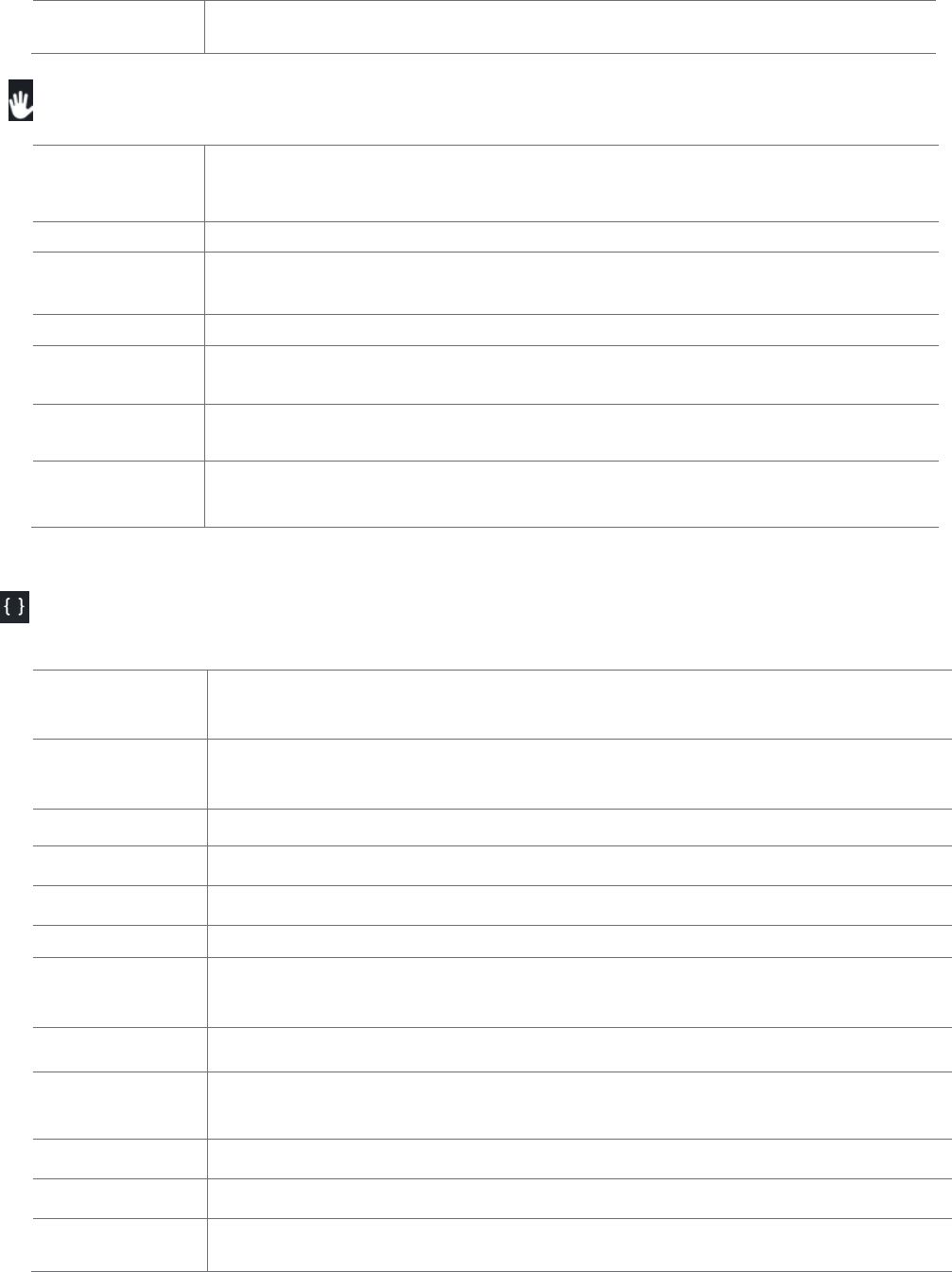
82
Select date
format
Select the format for displaying date.
Accessibility
Talkback
When talkback is on, your device provides spoken feedback to help blid and
low-vision users. For example, it describes what you touch, select, and activate.
Large text
Let the word large
Power button
ends call
When the icon is on, you can press power on/off icon ends call
Auto-rotate
screen
Let the phone auto rotate
Speak passwords
If you set the passwords, you can speak password unlock the phone
Touch &hold
delay
Set the time of touch &hold short, medium, long.
Install web
scripts
If you install scripts from Google that make their web content more accessible
Developer options
Take bug report
This will collect information about your current device state, to send as an e-
mail message.
Desktop backup
password
Desktop full backups aren’t currently protected
Stay awake
Screen will never sleep while charging
HDCP checking
Use HDCP checking for DRM content only
Protect SD card
Apps must request permission to read SD card
USB debugging
Debug mode when USB is connected
Allow mock
locations
Allow mock locations
Select debug app
You can select debugging application
Wait for
debugger
Debugged application waits for debugger to attach before executing
Show touches
Show visual feedback for touches
Pointer location
Screen overly showing current touch data
Show layout
dounds
Show clip bounds, margins, etc.

83
Show surface
updates
Flash entire window surfaces when they update
Window
animation scale
You can select the window animation scale
Transition
animation scale
You can select the Transition animation scale
Animator
duration scale
You can select the Animator duration scale
Disable HW
overlays
When you on Hw overlays always use GPU for screen compositing
Force GPU
rendering
When you on ,it will force use of GPU for 2d drawing
Strict mode
enabled
Flash screen when apps do long operations on main thread
Show CPU usage
When you on ,the screen overly showing current CPU usage
Profile GPU
rendering
Measure rending time in adb shell dumpsys gfxinfo
Enable traces
Select enabled traces
Don’t keep
activities
Delete every activity as soon as the leaves it
Background
process limit
Select background process limit
Show all ANRs
Show App Not Responding dialog for background apps
About phone
System updates
You can upgrade your system to up-to-date version.
Status
Information about your Phone number, signal, etc.
Legal
information
Legal information about Open source licenses and Google legal.
Model number
Check the Model number.
Android version
Check the android version
Baseband version
Check the baseband version.
Kernel version
Check the Kernel version.
Build number
The phone’s build number
Hardware
version
You can check hardware version.

84
Firmware Upgrade Using microSD Card
1. Download “update.zip” from supporting site.
2. Insert a microSD card into a PC.
3. Copy “update.zip” to the root directory of the microSD card.
4. Make sure the target device is power on with a fully charged battery.
5. Insert the microSD card into the card slot of the target device.
6. Tap to go to Settings>About phone and tap System update.
7. Choose the software from the SD card .
8. Tap Ok to reboot and update
9. During the period of update, the target device will automatically reboot for TWO times. Please
don’t operate the device until the update is completed.

85
Safety and use
Please read before proceeding
THE BATTERY IS NOT FULLY CHARGED WHEN YOU TAKE IT OUT OF THE BOX. DO
NOT REMOVE THE BATTERY PACK WHEN THE PHONE IS CHARGING. YOUR
WARRANTY IS INVALIDATED IF YOU DISASSEMBLE OR ATTEMPT TO DISASSEMBLE
THE DEVICE.
Privacy restrictions
Some countries require full disclosure of recorded telephone conversations, and stipulate that you
must inform the person with whom you are speaking that the conversation is being recorded.
Always obey the relevant laws and regulations of your country when using the recording feature of
your phone.
Disclaimers
ANY WEATHER, STOCK, OR OTHER INFORMATION, DATA, OR DOCUMENTATION
(“ACCESSED INFORMATION”) ARE PROVIDED “AS IS” AND WITHOUT ANY WARRANTY
OR ANY TECHNICAL SUPPORT. TO THE MAXIMUM EXTENT PERMITTED BY APPLICABLE
LAW, TCT MOBILE AND ITS AFFILIATES expressly disclaim any and all representations and
warranties, arising by law or otherwise, related to the Accessed Information, including without
limitation any express or implied representation or warranty of merchantability, fitness for a
particular purpose, non-infringement, quality, accuracy, completeness, effectiveness, reliability, or
usefulness. Without limiting the foregoing, it is further understood that TCT Mobile and its
Affiliates are not responsible for any use of the Accessed Information or the results arising from
such use and that you use such information at your own risk.
Limitation of damages
TO THE MAXIMUM EXTENT PERMITTED BY APPLICABLE LAW, IN NO EVENT SHALL TCT
MOBILE OR ITS AFFILIATES BE LIABLE TO YOU, ANY USER, OR THIRD PARTY FOR ANY
INDIRECT, SPECIAL, CONSEQUENTIAL, INCIDENTAL OR PUNITIVE DAMAGES OF ANY
KIND, ARISING IN CONTRACT, TORT, OR OTHERWISE, INCLUDING, BUT NOT LIMITED
TO, INJURY, LOSS OF REVENUE, LOSS OF GOODWILL, LOSS OF BUSINESS OPPORTUNITY,
LOSS OF DATA, AND/OR LOSS OF PROFITS, REGARDLESS OF THE
FORESEEABILITYTHEREOF OR WHETHER TCT MOBILE OR ITS AFFILIATES HAVE BEEN
ADVISED OF THE POSSIBILITY OF SUCH DAMAGES. AND IN NO EVENT SHALL THE
TOTAL LIABILITY OF TCT MOBILE OR ITS AFFILIATES EXCEED THE AMOUNT RECEIVED

86
FROM YOU, REGARDLESS OF THE LEGAL THEORY UNDER WHICH THE CAUSE OF
ACTION IS BROUGHT. THE FOREGOING DOES NOT AFFECT ANY STATUTORY RIGHTS
WHICH MAY NOT BE DISCLAIMED.
Important health information and safety precautions
When using this product, the safety precautions below must be taken to avoid possible legal
liabilities and damages. Retain and follow all product safety and operating instructions.
Observe all warnings in the operating instructions on the product.
To reduce the risk of bodily injury, electric shock, fire and damage to the equipment, observe the
following precautions.
Electrical safety
This product is intended for use when supplied with power from the designated battery or power
supply unit. Other usage may be dangerous and will invalidate any approval given to this product.
Safety precautions for proper grounding installation
Connecting to improperly grounded equipment can result in an electric shock to your device.
This product is equipped with a USB Cable for connecting with desktop or notebook computer. Be sure your
computer is properly grounded (earthed) before connecting this product to the computer. The power supply
cord of a desktop or notebook computer has an equipment grounding conductor and a grounding plug. The
plug must be plugged into an appropriate outlet which is properly installed and grounded in accordance with
all local codes and ordinances.
Safety precautions for power supply unit
Use the correct external power source
A product should be operated only from the type of power source indicated on the electrical
ratings label. If you are not sure of the type of power source required, consult your authorized
service provider or local power company. For a product that operates from battery power or other
sources, refer to the operating instructions that are included with the product.
This product should be operated only with the following designated power supply unit(s).
Travel charger: Input: 100-240 V, 50/60 Hz,
0.15 A Output: 5 V, 2000 mA
Handle battery packs carefully
This product contains a Lithium-ion polymer or Lithium-ion battery. There is a risk of fire and
burns if the battery pack is handled improperly. Do not attempt to open or service the battery pack.
Do not disassemble, crush, puncture, short external contacts or circuits, dispose of in fire or water,
or expose a battery pack to temperatures higher than 140°F (60°C).

87
Danger of explosion if battery is incorrectly replaced. To reduce risk of fire or burns, do not disassemble, crush,
puncture, short external contacts, expose to temperature above 140°F (60°C), or dispose of in fire or water.
Replace only with specified batteries. Recycle or dispose of used batteries according to the local regulations or
reference guide supplied with your product.
Take extra precautions
• Keep the battery or device dry and away from water or any liquid as it may cause a short
circuit.
• Keep metal objects away so they don’t come in contact with the battery or its connectors as it
may lead to short circuit during operation.
• The phone should only be connected to products that bear the USB-IF logo or have
completed the USB-IF compliance program.
• Do not use a battery that appears damaged, deformed, or discolored, or the one that has
any rust on its casing, overheats, or emits a foul odor.
• Always keep the battery out of the reach of babies and small children, to avoid swallowing
of the battery. Consult the doctor immediately if the battery is swallowed.
• Only use the battery with a charging system that has been qualified with the system per this
standard, IEEE-Std-172
5-2006. Use of an unqualified battery or charger may present a risk of fire, explosion, leakage or
other hazard.
• Replace the battery only with another battery that has been qualified with the system per this
standard, IEEE-Std-172
5-2006. Use of an unqualified battery may present a risk of fire, explosion, leakage or other
hazard.
• Avoid dropping the phone or battery. If the phone or battery is dropped, especially on a
hard surface, and the user suspects damage, take it to a service center for inspection.
• If the battery leaks:
• Do not allow the leaking fluid to come in contact with skin or clothing. If already in contact,
flush the affected area immediately with clean water and seek medical advice.
• Do not allow the leaking fluid to come in contact with eyes. If already in contact, DO NOT
rub; rinse with clean water immediately and seek medical advice.

88
• Take extra precautions to keep a leaking battery away from fire as there is a danger of
ignition or explosion.
Safety precautions for direct sunlight
Keep this product away from excessive moisture and extreme temperatures. Do not leave the
product or its battery inside a vehicle or in places where the temperature may exceed 140°F (60°C),
such as on a car dashboard, window sill, or behind a glass that is exposed to direct sunlight or
strong ultraviolet light for extended periods of time. This may damage the product, overheat the
battery, or pose a risk to the vehicle.
Prevention of hearing loss
Permanent hearing loss may occur if earphones or headphones are used at high volume for
prolonged periods of time.
Safety in aircraft
Due to the possible interference caused by this product to an aircraft’s navigation system and its
communications network, using this device’s phone function on board an airplane is against the
law in most countries. If you want to use this device when on board an aircraft, remember to turn
off your rf on your phone by switching to Airplane Mode.
Environment restrictions
Do not use this product in gas stations, fuel depots, chemical plants or where blasting operations
are in progress, or in potentially explosive atmospheres such as fuelling areas, fuel storehouses,
below deck on boats, chemical plants, fuel or chemical transfer or storage facilities, and areas
where the air contains chemicals or particles, such as grain, dust, or metal powders. Please be
aware that sparks in such areas could cause an explosion or fire resulting in bodily injury or even
death.
Explosive atmospheres
When in any area with a potentially explosive atmosphere or where flammable materials exist, the
product should be turned off and the user should obey all signs and instructions. Sparks in such
areas could cause an explosion or fire resulting in bodily injury or even death. Users are advised not
to use the equipment at refueling points such as service or gas stations, and are reminded of the
need to observe restrictions on the use of radio equipment in fuel depots, chemical plants, or where
blasting operations are in progress. Areas with a potentially explosive atmosphere are often, but not
always, clearly marked. These include fueling areas, below deck on boats, fuel or chemical transfer
or storage facilities, and areas where the air contains chemicals or particles, such as grain, dust, or
metal powders.
Road safety
89
Full attention must be given to driving at all times in order to reduce the risk of an accident. Using
a phone while driving (even with a hands free kit) causes distraction and can lead to an accident.
You must comply with local laws and regulations restricting the use of wireless devices while
driving.
Safety precautions for RF exposure
• Avoid using your phone near metal structures (for example, the steel frame of a building).
• Avoid using your phone near strong electromagnetic sources, such as microwave ovens,
sound speakers, TV and radio.
• Use only original manufacturer-approved accessories, or accessories that do not contain any
metal.
• Use of non-original manufacturer-approved accessories may violate your local RF exposure
guidelines and should be avoided.
Interference with medical equipment functions
This product may cause medical equipment to malfunction. The use of this device is forbidden in
most hospitals and medical clinics.
If you use any other personal medical device, consult the manufacturer of your device to
determine if they are adequately shielded from external RF energy. Your physician may be able
to assist you in obtaining this information.
Turn your phone OFF in health care facilities when any regulations posted in these areas
instruct you to do so. Hospitals or health care facilities may be using equipment that could be
sensitive to external RF energy.
Nonionizing radiation
Your device has an internal antenna. This product should be operated in its normal-use position to
ensure the radioactive performance and safety of the interference. As with other mobile radio
transmitting equipment, users are advised that for satisfactory operation of the equipment and for
the safety of personnel, it is recommended that no part of the human body be allowed to come too
close to the antenna during operation of the equipment.
Use only the supplied integral antenna. Use of unauthorized or modified antennas may impair
call quality and damage the phone, causing loss of performance and SAR levels exceeding the
recommended limits as well as result in non-compliance with local regulatory requirements in
your country.
To assure optimal phone performance and ensure human exposure to RF energy is within the
guidelines set forth in the relevant standards, always use your device only in its normal-use
position. Contact with the antenna area may impair call quality and cause your device to operateat
a higher power level than needed. Avoiding contact with the antenna area when the phone is IN
USE optimizes the antenna performance and the battery life.
90
Electrical safety
Accessories
• Use only approved accessories.
• Do not connect with incompatible products or accessories.
• Take care not to touch or allow metal objects, such as coins or key rings, to contact or short
circuit the battery terminals.
Connection to a car
Seek professional advice when connecting a phone interface to the vehicle electrical system.
Faulty and damaged products
• Do not attempt to disassemble the phone or its accessory.
• Only qualified personnel must service or repair the phone or its accessory.
General precautions
You alone are responsible for how you use your phone and any consequences of its use. You must
always switch off your phone wherever the use of a phone is prohibited. Use of your phone is
subject to safety measures designed to protect users and their environment.
Avoid applying excessive pressure to the device
Do not apply excessive pressure on the screen and the device to prevent damaging them and
remove the device from your pants’ pocket before sitting down. It is also recommended that you
store the device in a protective case and only use the device stylus or your finger when interacting
with the touch screen. Cracked display screens due to improper handling are not covered by the
warranty.
Device getting warm after prolonged use
When using your device for prolonged periods of time, such as when you’re talking on the phone,
charging the battery or browsing the Web, the device may become warm. In most cases, this
condition is normal and therefore should not be interpreted as a problem with the device.
Heed service markings
Except as explained elsewhere in the Operating or Service documentation, do not service any
product yourself. Service needed on components inside the device should be done by an authorized
service technician or provider.
Protect your phone
91
• Always treat your phone and its accessories with care and keep them in a clean and dust-free
place.
• Do not expose your phone or its accessories to open flames or lit tobacco products.
• Do not expose your phone or its accessories to liquid, moisture or high humidity.
• Do not drop, throw or try to bend your phone or its accessories.
• Do not use harsh chemicals, cleaning solvents, or aerosols to clean the device or its accessories.
• Do not paint your phone or its accessories.
• Do not attempt to disassemble your phone or its accessories, only authorized personnel must
do so.
• Do not expose your phone or its accessories to extreme temperatures, minimum -4°F (-
20°C) and maximum 122°F (50°C).
• Please check local regulations for disposal of electronic products.
• Do not carry your phone in your back pocket as it could break when you sit down. Damage
requiring service
Unplug the product from the electrical outlet and refer servicing to an authorized service technician
or provider under the following conditions:
• Liquid has been spilled or an object has fallen into the product.
• The product has been exposed to rain or water.
• The product has been dropped or damaged.
• There are noticeable signs of overheating.
• The product does not operate normally when you follow the operating instructions.
Avoid hot areas
The product should be placed away from heat sources such as radiators, heat registers, stoves, or
other products (including amplifiers) that produce heat.
Avoid wet areas
Never use the product in a wet location.
Avoid using your device after a dramatic change in temperature
When you move your device between environments with very different temperature and/or
humidity ranges, condensation may form on or within the device. To avoid damaging the device,
allow sufficient time for the moisture to evaporate before using the device.
NOTICE: When taking the device from low-temperature conditions into a warmer environment
or from high-temperature conditions into a cooler environment, allow the device to
acclimate to room temperature before turning on power.
Avoid pushing objects into product
92
Never push objects of any kind into cabinet slots or other openings in the product. Slots and
openings are provided for ventilation. These openings must not be blocked or covered.
Air bags
Do not place a phone in the area over an air bag or in the air bag deployment area. Store the phone
safely before driving your vehicle.
Mounting accessories
Do not use the product on an unstable table, cart, stand, tripod, or bracket. Any mounting of the
product should follow the manufacturer’s instructions, and should use a mounting accessory
recommended by the manufacturer.
Avoid unstable mounting
Do not place the product with an unstable base.
Use product with approved equipment
This product should be used only with personal computers and options identified as suitable for use
with your equipment.
Adjust the volume
Turn down the volume before using headphones or other audio devices. Cleaning
Unplug the product from the wall outlet before cleaning. Do not use liquid cleaners or aerosol
cleaners. Use a damp cloth for cleaning, but NEVER use water to clean the LCD screen. Small
children
Do not leave your phone and its accessories within the reach of small children or allow them to play
with it. They could hurt themselves or others, or could accidentally damage the phone. Your phone
contains small parts with sharp edges that may cause an injury or which could become detached and
create a choking hazard.
Repetitive motion injuries
To minimize the risk of RSI, when Texting or playing games with your phone:
• Do not grip the phone too tightly
• Press the buttons lightly
• Make use of the special features in the handset which minimize the number of buttons which
have to be pressed, such as message templates and predictive text.
• Take lots of breaks to stretch and relax.
Operating machinery
Full attention must be given to operating the machinery in order to reduce the risk of an accident.
Loud noise
This phone is capable of producing loud noises which may damage your hearing.
Emergency calls
This phone, like any wireless phone, operates using radio signals, which cannot guarantee
connection in all conditions.Therefore, you must never rely solely on any wireless phone for
emergency communications.
93
Regulatory agency identifications
FCC Regulations:
This mobile phone complies with part 15 of the FCC Rules. Operation is subject to the following two
conditions: (1) This device may not cause harmful interference, and (2) this device must accept any
interference received, including interference that may cause undesired operation.
This mobile phone has been tested and found to comply with the limits for a Class B digital device,
pursuant to Part 15 of the FCC Rules. These limits are designed to provide reasonable protection
against harmful interference in a residential installation. This equipment generates, uses and can
radiated radio frequency energy and, if not installed and used in accordance with the instructions,
may cause harmful interference to radio communications. However, there is no guarantee that
interference will not occur in a particular installation If this equipment does cause harmful
interference to radio or television reception, which can be determined by turning the equipment off
and on, the user is encouraged to try to correct the interference by one or more of the following
measures:
-Reorient or relocate the receiving antenna.
-Increase the separation between the equipment and receiver.
-Connect the equipment into an outlet on a circuit different from that to which the receiver is
connected.
-Consult the dealer or an experienced radio/TV technician for help.
Changes or modifications not expressly approved by the party responsible for compliance could void
the user‘s authority to operate the equipment.

94
RF Exposure Information (SAR)
This mobile phone meets the government’s requirements for exposure to radio waves.
This phone is designed and manufactured not to exceed the emission limits for exposure to radio
frequency (RF) energy set by the Federal Communications Commission of the U.S. Government.
The exposure standard for wireless mobile phones employs a unit of measurement known as the
Specific Absorption Rate, or SAR. The SAR limit set by the FCC is 1.6W/kg. *Tests for SAR are
conducted using standard operating positions accepted by the FCC with the phone transmitting at its
highest certified power level in all tested frequency bands. Although the SAR is determined at the
highest certified power level, the actual SAR level of the phone while operating can be well below the
maximum value. This is because the phone is designed to operate at multiple power levels so as to
use only the power required to reach the network. In general, the closer you are to a wireless base
station, the lower the power output.
The highest SAR value for the model phone as reported to the FCC when tested for use at the ear is
0.43 W/kg and when worn on the body, as described in this user guide, is 0.93 W/kg (Body-worn
measurements differ among phone models, depending upon available accessories and FCC
requirements.)
While there may be differences between the SAR levels of various phones and at various positions,
they all meet the government requirement.
The FCC has granted an Equipment Authorization for this model phone with all reported SAR levels
evaluated as in compliance with the FCC RF exposure guidelines. SAR information on this model
phone is on file with the FCC and can be found under the Display Grant section of
www.fcc.gov/oet/ea/fccid after searching on FCC ID: P46-U675.
For body worn operation, this phone has been tested and meets the FCC RF exposure guidelines for
use with an accessory that contains no metal and the positions the handset a minimum of 1 cm from
the body. Use of other accessories may not ensure compliance with FCC RF exposure guidelines. If
you do no t use a body-worn accessory and are not holding the phone at the ear, position the handset
a minimum of 1 cm from your body when the phone is switched on.

95
HEARING AID COMPATIBILITY HAC FOR WIRELESS
TELECOMMUNICATIONS DEVICES
THIS PHONE HAS A HAC RATING OF M3/T3
WHAT IS HEARING AID COMPATIBILITY?
The Federal Communications Commission has implemented rules and a rating system designed to
enable people who wear hearing aids to more effectively use these wireless telecommunications
devices. The standard for compatibility of digital wireless phones with hearing aids is set forth in
American National Standard Institute (ANSI) standard C63.19. There are two sets of ANSI
standards with ratings from one to four (four being the best rating): an “M” rating for reduced
interference making it easier to hear conversations on the phone when using the hearing aid
microphone, and a “T” rating that enables the phone to be used with hearing aids operating in the
telecoil mode thus reducing unwanted background noise.
HOW WILL I KNOW WHICH WIRELESS PHONES ARE HEARING AID COMPATIBLE?
The Hearing Aid Compatibility rating is displayed on the wireless phone box.
A phone is considered Hearing Aid Compatible for acoustic coupling (microphone mode) if it has an
“M3” or “M4” rating. A digital wireless phone is considered Hearing Aid Compatible for inductive
coupling (telecoil mode) if it has a “T3” or “T4” rating.
Hearing aid category
3
WD emission rating
3
System classification
(SUM)
6
Remark:
A sum of 5: normal use.
A sum of 6 or greater: excellent performance.
A sum of less than 4 would likely result in a performance that is judged unacceptable by the hearing aid user.
HOW WILL I KNOW IF MY HEARING AID WILL WORK WITH A PARTICULAR DIGITAL
WIRELESS PHONE?
You’ll want to try a number of wireless phones so that you can decide which works the best with
your hearing aids. You may also want to talk with your hearing aid professional about the extent to
which your hearing aids are immune to interference, if they have wireless phone shielding, and
whether your hearing aid has a HAC rating.
